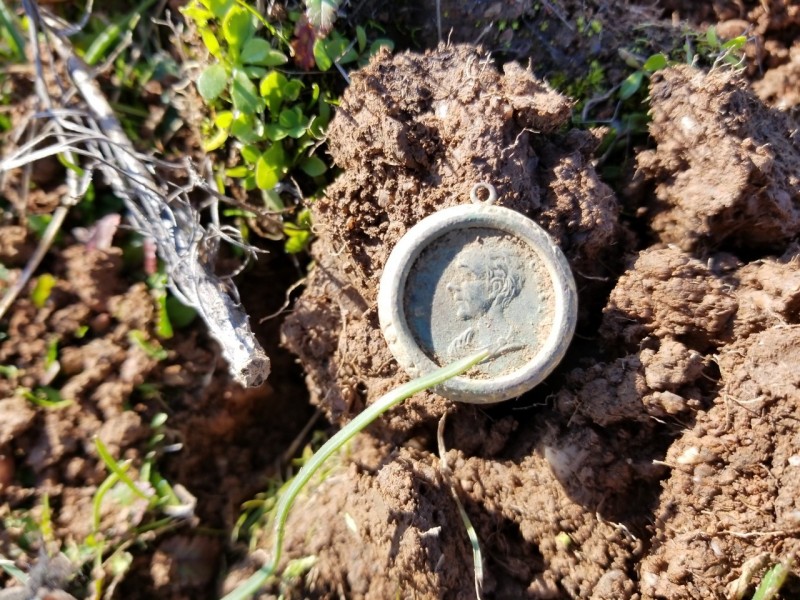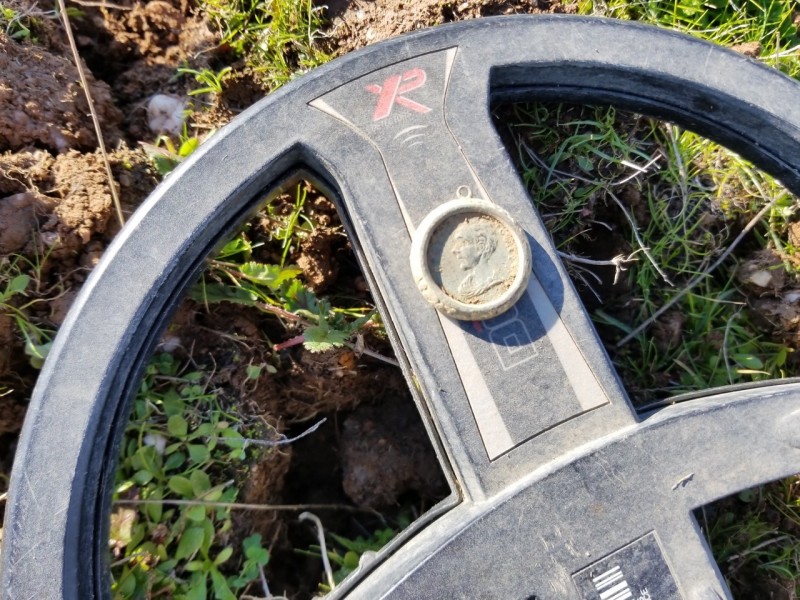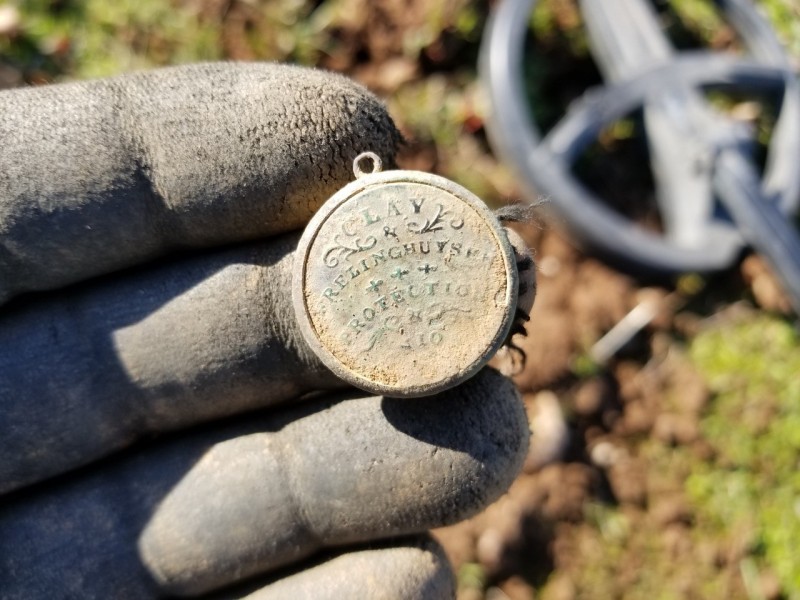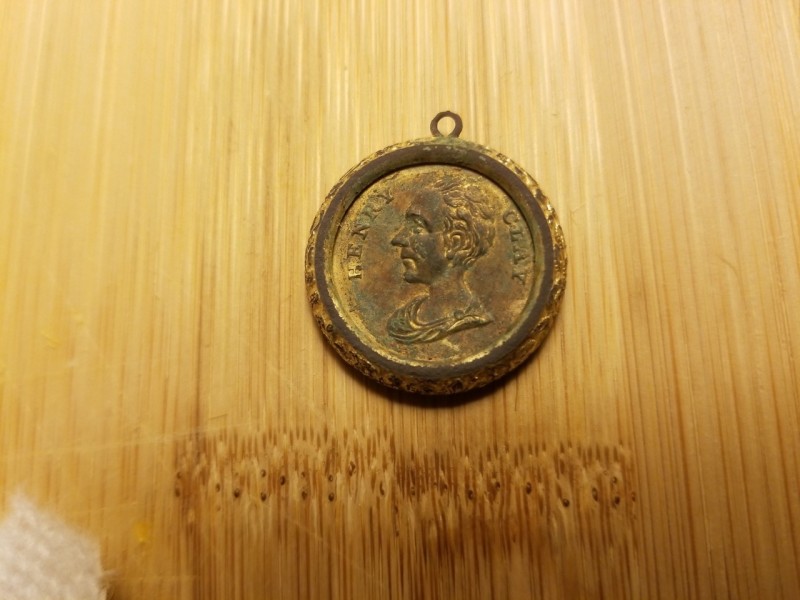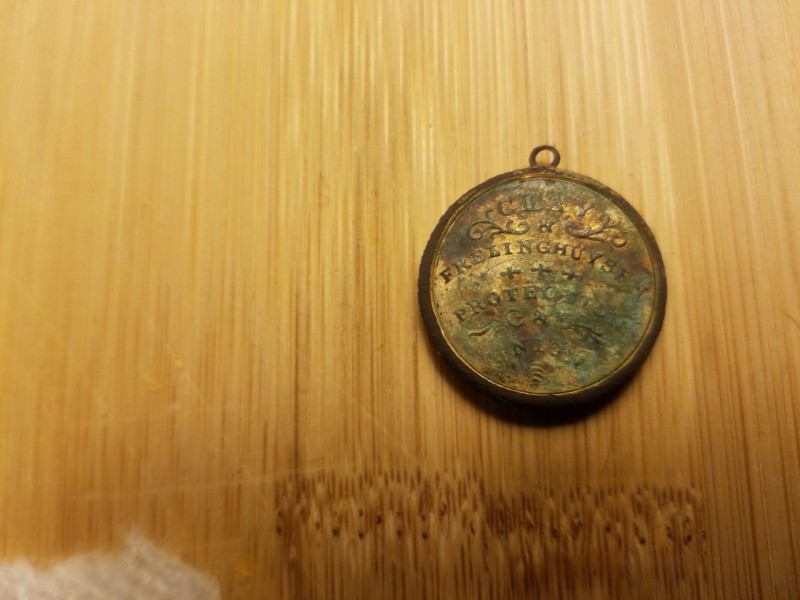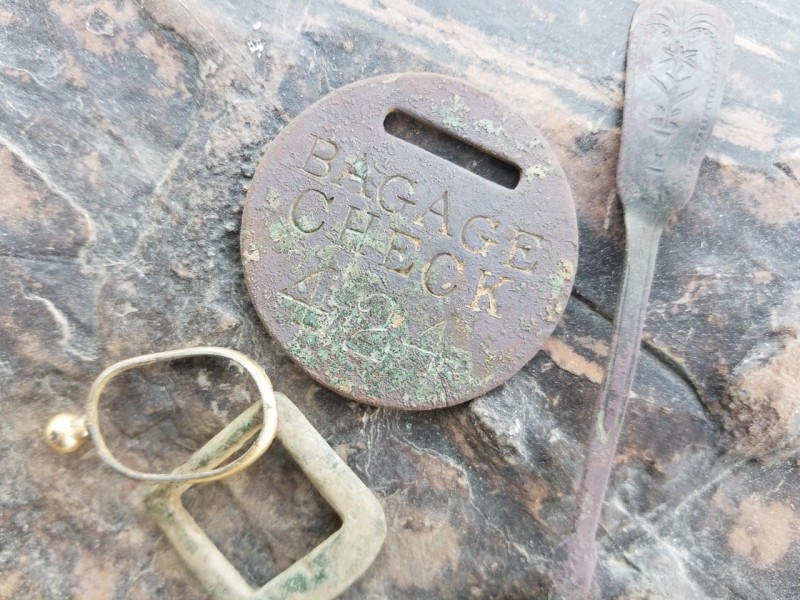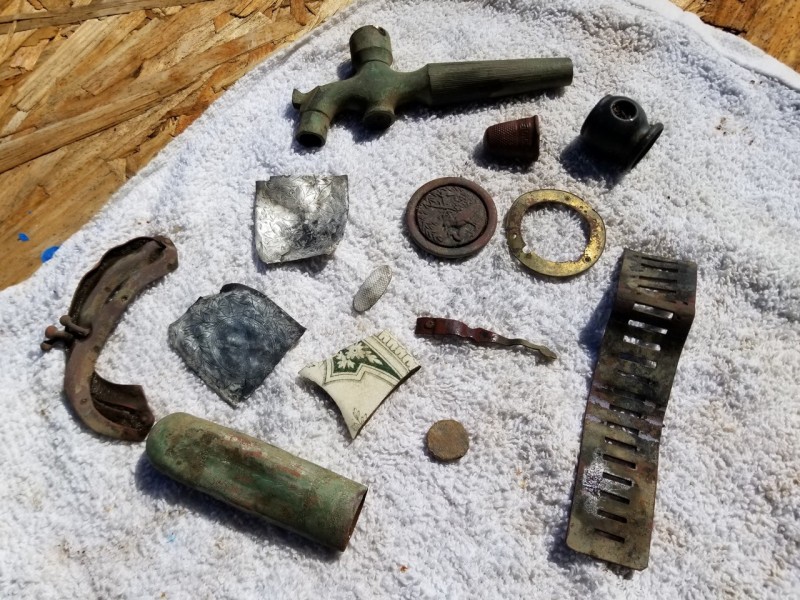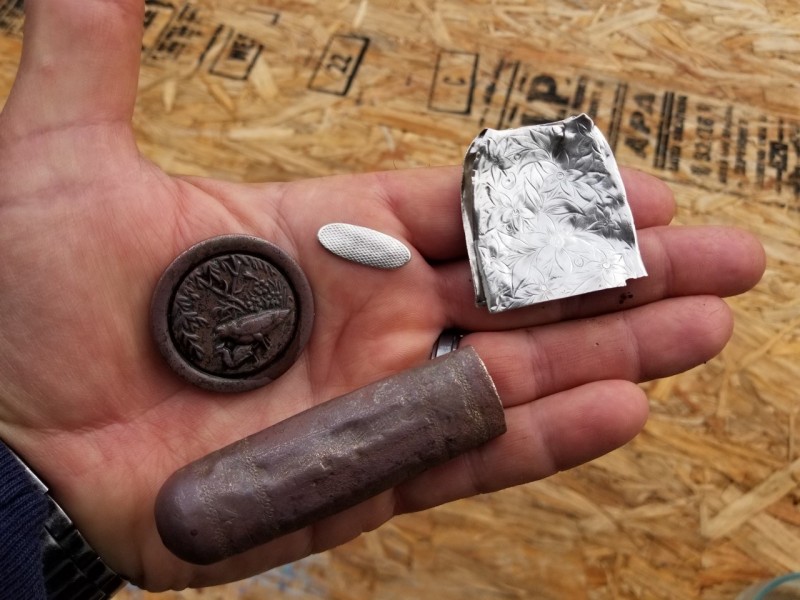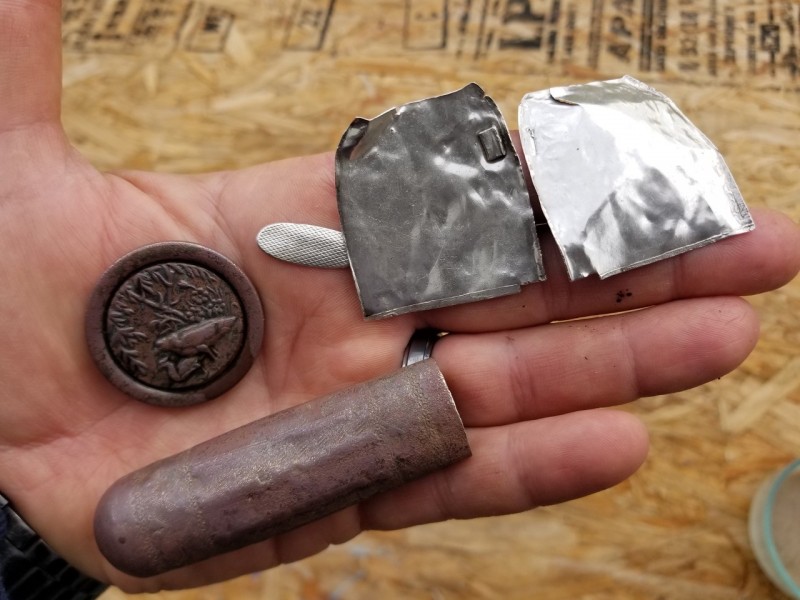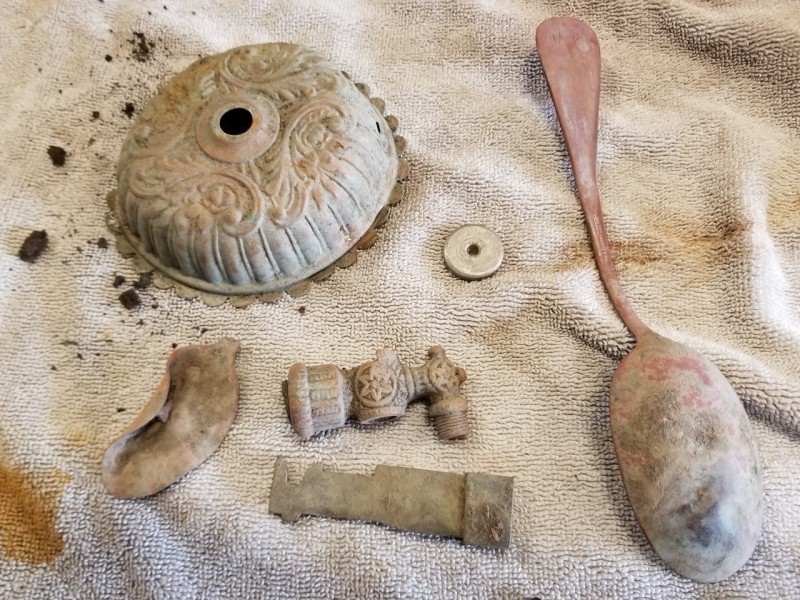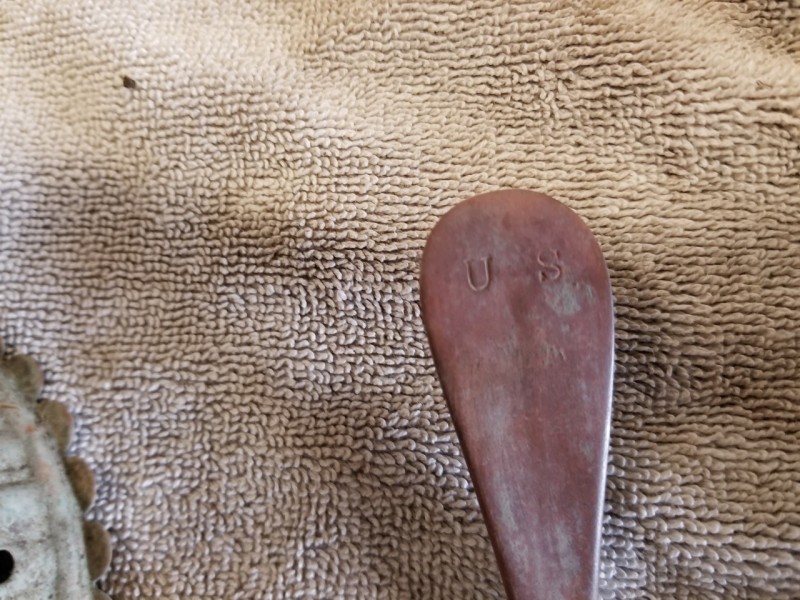Search the Community
Showing results for tags 'relic detecting'.
-
I've found all these lumps of lead over a number of years and kept them together, and I just found them again in a box in the corner of a dark cupboard - and thought it worth a post. Here in England we luckily haven't seen any real internal military fighting since the English Civil War (c1640's) so most bullets and musket balls we find all over the place were from hunting, practice or just recreation (not from battlefields). From the time of Elizabeth I (c1570's) the focus has been local training and good practice just in case anyone decided to invade. In Victorian times local militia units, rifle companies and training took place pretty well everywhere. These finds, are often not obvious and thrown in with the junk lead - I think are really good examples of what they are. They also come in a massive variety of annoying smaller fragments. The Minie bullets I have phrased as mushroom (fairly obvious why) and shoot-through. A shoot-through from where the base of the bullet, after the bullet hitting something soft?, has pushed through the soft hot lead and turned the bullet inside out. There may be some technical phrase for these things, but in my mind this is what I call them if ever found. A pancake is a flat one, fired at something hard, and normally having an imprint of sandstone brick, or rough hewn granite - the common stone for dry stone walls, or gate posts for the well off farmers of old. The silver coin is a Victorian sixpence. It has been used as a target and suffered the consequences - but probably from a later jacketed .303 bullet as tiny bits of copper are embedded in the silver after the massive force of impact obliterated it.
-
After a recent multi day erosion event, Equinox owners racked up on musket balls and other relics. The majority of detectors were the NOX. Then with a few degrees wind shift it’s all over until the next time.
-
I'm having a bout of lack of confidence in my MK. My second 11'' coil today started to act just like my old one. (CRAP)... Short story - Went over an area and hit a high 90's number and broken signal. My buddy with the 800 went over it and dug two silver quarters a 1929 and a 1942. So here's my question to all, Do I get a Nox 800???? I mostly coin and relic hunt, with a beach maybe twice a year. So I want the good the bad and the ugly. honest and true answers on performance, warranty and coil choices. I'm not a big fan of the tones, but I might be able to forgive that for a more stable running machine. Not looking for overly complicated either. I keep hearing that there is a BIG learning curve? Can you run in factory settings and still be happy? or do you have to be a mathematician to learn it? I do not want to carry 50 index cards with setting numbers!!! SO all that own and run one please let me know your thoughts good or bad. Just looking for help before pissing away another $1200+ God help me, I'm running out of excuses for my wife, so you members better give me some good answers.
- 44 replies
-
- 3
-

-
- relic detecting
- jewelry detecting
-
(and 1 more)
Tagged with:
-
Hit the river as the tide was on the way in and got a few digs in. Large plate looks like it was for a mail slot. Might have come from an old colonial up the road based on the #. Small bronze or brass buckle maybe from a satchel or something, small what seems to be a pewter button which is probably the oldest of the finds but I have no idea the age on it. The religious pendant seems to be brass and has 2 different characters one on each side. Glass door knob guessing late 1800's. Last is a brass plate with the words Radio Corporation on the bottom but can't make out the other text above, guessing it is from one the old tube radios with wood case probably 1940's? Not that it matters but used the Multi Kruzer 14khz and jumped between all metal and 3 tone.
-
Coming from using mainly the XP Deus on many of my local 1800's sites, I purchased an Equinox 600 to compliment the Deus and to see how it would fare over the same sites. Whilst I am still learning the Nox, so far it has impressed on both depth and ability to squeeze some more targets from what is some pretty difficult ground due to iron contamination (plenty of large nails). Of particular interest was how well it does on the mid to low conductors (damned .22 casings), and in one case pulling an 1863 British penny, fob watch winder and a large iron nail from the same hole. Am pretty keen to re-visit many other local sites to see what other surprises the 600 can offer.
-
I have been around this hobby for over 35 years and went from the guy that had no idea what ground balance or gain meant to where I am today. It has taken thousands of hours of research and time, putting good detecting habits into practice. I, myself, have been very fortunate to be around some of the best diggers that have ever held a metal detector in their hands. If anyone ever thinks they are the best and they can’t get any better or learn more about what we do, then they are sadly mistaken. To this day I continue to learn every time I turn on and start swinging. Being associated with these guys for the last several years has really given me an insight that very few people will ever have. The team of diggers I work with are some of the best and most successful group you will ever find. Our fearless leader keeps us up to date on new machines and technology to keep us at a level we have attained. Now, how do you become the best detectorist you can be? First of all you must have an open mind and be willing to listen to the right people for instruction. In the past, I have been a involved in both Archery and Bowling to high degree. Those 2 sports taught me a very valuable lesson, if you want to be the best you can be, then learn from the best, someone that is very successful. I spent a lot of money buying the wrong stuff by listening to the “expert” that didn’t have a clue. I have learned how to do research from whom to seek advice. I run into people all the time that are wanting to get better, but they listen to people that have a good line but, don’t have the success to back up their claims. It sometimes is hard to get rid of bad habits, whether it is in your swing or the way you do research. YouTube is nice and there are some good videos and knowledge to be found on the site. However, there is also a lot of wanting to be people giving some not so good advice. It’s important that you as a viewer know the difference. You ask how do I know, again look at what they have found. A few old coins or a couple of gold nuggets doesn’t mean they have the knowledge you seek. Another thing is don’t keep changing the settings on your machine because this guy says it is the best way to do it. Learn your machine from testing buried targets to find out what works to get the best results in your area. There are no magic setting, there is however very good setting to start and work with to get your best performance. You will never be good if you are always changing your detector from this guys or to the next video guy that knows it all. YOU must learn how your machine works and when you need to change settings. Learn the sounds, do not depend on the ID’S # on when to dig. They are for a reference point to what might be the target. It takes years of dedication to understand this hobby. Now let’s talk about the detector that you have or want to get. I get asked all the time WHAT IS THE BEST MACHINE? The simple answer is “none” are the best at every task. And beyond that is what task are you wanting to use the detector. How about the selection of coils (not loops or heads) is compatible with a metal detector. What is the cost of the metal detector and the selection of coils you are going to need for your task? Not everyone can afford the most expensive detector on the market. But, if goal is to be the best nugget hunter you can be and are committed to that end, then, YES the Minelab GPZ-7000 is a machine you would definitely want to consider for Gold Nugget Hunting. To be honest, I am a bit prejudice about the brands of detectors I use so keep that in mind, but I use the one’s I use because they are the machines that I feel are the best for me and the tasks I want use them. That being said, here is what I have for my needs: GPZ-7000 GPX-5000 CTX-3030 FISHER GOLD BUG-2 XP DEUS These are not the only machines but they are my choice, do your research to find yours. THIS IS MY OPINION: Yes, I put in thousands of hours swinging and learning and have found over a thousand gold nuggets and some nice coins and relics. Why did I pick those machines? It is simple for me. When it comes to finding Gold Nuggets, Minelab is unsurpassed for depth on larger nuggets. That is why I have the GPZ-7000 and the GPX- 5000. Those two machines are similar but not the same. There are times when the GPX-5000 will outshine the GPZ-7000 and so that is the one bring out of the truck. If you are hunting nuggets in an area that has had a lot of miners camping and leaving iron items and trash behind, then discrimination may be needed and the GPX-5000 is the detector I want to use. When hunting in the Nevada desert where ferrous items are limited and nuggets of all sizes are possible to be found then the GPZ-7000 is my first choice. I have owned all the Minelab series from the GP 3500 up to the GPZ-7000. The GP series detectors have been the best gold finding detectors of their time. I have been fortune enough to find enough gold to justify the investment and I believe if you have the proper tools to get the job done correctly your chances of success becomes greater. The Fisher Gold Bug-2 is designed to find smaller and shallower gold and mean from fly *#*# to nice gold in the mineralized shallow ground. It is hard to beat the Gold Bug-2 when it comes to finding really small gold, but the Newer Minelab SDC-2300 comes very close but doesn’t have iron discrimination if that is needed. The last detector I use for hunting gold is the XP Deus. Now where would I use a multi purpose coin, relic and gold machine, in tailing piles looking for specimen gold. Again, these are my choices and for tailing piles The XP Deus is not the only detector that is good for the job, the Minelab X-terra 705 is the choice for a couple of the successful team members. When it comes to coin and relic hunting the Minelab CTX-3030 is what I find works best for me. One of the reasons I like this machine because it is waterproof. If you choose to hit the lake or beach you don’t have to worry about getting it wet and it works outstanding in the water while jewelry hunting. It has a good selection of coils to cover your hunting needs. In high iron areas I use the 6 inch coil and if the area it is a more open and uncluttered spot with deep coins the 17 inch monster coil would be the choice. The Stock coil works great for all around detecting conditions. The CTX-3030 or Minelab’s SDC-2300 are some of the best in water looking for those platinum, gold and silver rings. Again, there are other choices, but the CTX has it all and it covers most all of my coil and relic hunting needs. The XP Deus however, is a good choice with very heavy iron where the coins are close to the ferrous objects. I have paid for the XP Deus in a couple spots, finding some very nice targets lying too close to iron that the CTX was unable to find. I always use both units when I am in an area where old goodies are coming out of the ground. Back to how to become the best you can be. It takes hours and hours of using the correct techniques to become consistent in producing good finds. But just knowing your detector and technique is not enough by any means! The first part of becoming successful is doing the research to get you to a good spot. You can’t just always follow your buddies to get you to a good area. If they have been there, then you are looking for the left overs. It is fairly easy to find the cream in a spot, but to find what is below the cream and mixed in with the ferrous targets, or just plain DEEP TARGETS is what we are trying to do. You must put in the time to be successful. Wanting to find older coins and relics, then you have to be at a site that can hold those old items. The local city park is probably not your best choice but can be a very good place to practice honing your skills. The same holds true for a school yard. Lots of targets to get in some practice. With all the junk targets you can perfect your swing speed, coil control and keeping your coil level to the ground all the way through your swing. Learn how to separate targets and look for the deep ones, not the easy ones in the top 4 or 5 inches. Pass those up and leave those for later, but instead listen for the faint deep signals. The deep signals should be the better coins and relics. Look at the ground to see if has been turned over or fill has been added. While driving around look for old trees or stumps that have been there for years. Watch for older homes, especially ones that have bad lawn care. It can increase your chance to detect. Empty lots where old homes once stood. Look for foundations in those lots along with colored glass and trash from days gone by. Research at city hall or the library from where old roads or buildings once stood. Get photos from the era of when the community or mining camp was first started. Look at areas that didn’t have electricity back in the day, especially mine sites. Look for old maps of towns, forts or mining camps that are not on today's maps. The internet is a great source of information, but books and maps are usually the best way to go. As my detecting partner has told countless people, you will spend hundreds and even thousands of dollars buying that perfect detector, but you won’t spend a $100 a year buying research material to get you to those spots no one else finds. They are still out there. Research is all part of learning how to become successful. Coils are always a hot topic. What coil do I need? Well, you need the one designed to do the task you are attempting. If you are looking for shallow small targets, then a huge coil is not a good choice. Same way if you are looking for deep targets a small coil is not correct choice. Are you going to use discrimination, if so, you will need a DD coil. If you are after depth and sensitivity the mono coil is what you will want because they are more sensitive than their DD partners. There is also concentric coils on our coin and relic machines. You need to match the right coil to the task at hand. Smaller coils are designed to find smaller shallow targets. Big coils are made to go deep looking for that Lunker or deep coin, but if there is a small target at depth the big coil will most likely not see it and the small coil can’t see that deep so what does that mean. You simply can’t get them all unless you are scraping off a few inches at a time down to bedrock but we do try. Again, do some testing, if you are a nugget hunter then buy yourself some lead (Bird shot and fishing weights) in different sizes and put them in the ground at different depths and TEST!!! Coin hunters bury those coins in the ground so you can barely hear them. That serves two purposed, practice on faint targets and the opportunity to try different modes and setting to see what works in real life. Air tests are ok, but the mineralization and wetness in the ground tell the real story. That way you know what works and what doesn’t. That gives you the confidence and so you will not have to wonder if your machine and coil combination is correct. You will know! Confidence is a good thing. That is how we all have learned, practice practice practice…. You don’t have to be in the gold fields or a ghost town to become better on your detector. Instead of sitting on your couch go outside and put in some time learning about to make the machine and you work together to be successful. You might be surprised about how you want to get out there and find the get swinging after honing your skill level. If you have a family, what a way to spend some quality time together. And mom and dad you know the kids are going to get better than you. In conclusion, you want to be really good or just so so, the choice is yours. Everyone doesn’t want to be a Pro but if you do, it requires time, energy, investment and a lot of hours swing an digging. Remember, if you want to be the best then learn what you can from the successful hunter. Detector classes give you a huge leap forward to becoming successful. The final word is something I did hear on a video from a fellow digger: “Look of a reason to dig not for an excuse not to dig” Thanks for your time, Rye Patch Ron PS: Always fill in your holes, ask permission and leave it as good or better than before you dug.
- 13 replies
-
- 13
-

-
- best detector
- coin detecting
-
(and 1 more)
Tagged with:
-
Small skating pond has dried up a bit, enough to walk around in and detect. I'm amazed how much trash was in it but was able to poke around with my Gold Racer. Wish it had a bigger coil but love using it for coin and relic hunting. Pic of the pond, usually always has water in it and the lilly pads and arrow weed are still green on the edges. Bottom was dry enough to walk on. Ground had cracks and voids in the mud that gave some negative signals at times. Gravel and stones are few inches down but thinking there is stuff out of range of coil i was using. Brass candle stick base (rest was missing), small brass pin with a floral pattern on it that had a bit of silver plating on it and bit of clad. The 1948 p Rosie was from another section of the woods. Will hit that again with one of my other machines and bring more than just my hand digger.
-
Hi everybody! The artifacts we are now detecting have been truly incredible so we are putting together a 3 part series on this site to share them with anyone who is interested! We could use some help ID’ing a couple things and we hope you love seeing these things as much as we loved finding them! Heres Part 1
-
Hi everybody- another beautiful weekend in the PNW and some great relics and history uncovered. Check out our expedition!
-
- 1
-

-
- relic found
- relic detecting
-
(and 1 more)
Tagged with:
-
After another long hot week and some things that are weighing heavy on my heart. I decided to hunt a little woodlot and creek to take my mind off the grind of life. I walked about 1000 yds down the creek with little luck until I found a odd item that looks like an umbrella handle. A short distance later I retrieved a very very small tea cup (cool). After striking out on the water, I thought that I might have better luck on terrafirma. Shotgun cases woo hoo!!! I then decided to hunt near a giant of an oak tree, every bit of 40'' through. Hoping for something good, I got a good deep hit. At around 11'' out popped a very large musket ball that measures .690 to .695. Thinking from a british brown bess. Spent another hour farting around and tripped up on a 97 number that kept bouncing down to the high 70's. Normally this would be coal, but the tone did not have the crackle that coal usually has. Woo Hoo out popped a 45 mercury dime. My second 45 in a very short time. Turns out that there were very small fragments of coal around the merc. The dime is cool, but I love Rev. War musket balls!!!! I ended my day with a 22 casing and a 22 bullet. Another good day with the MK!!! Time to have a beer and cool off!!!
- 5 replies
-
- 10
-

-
- makro kruzer
- relic detecting
-
(and 1 more)
Tagged with:
-
A few finds from a recent detecting trip to a Colorado ghost town/mining camp. Found a token, brooch with a stone, numbered tag, ring, thimble, brass lock, crucible, marbles, buttons and the regular ghost town finds, some you can identify, others still trying to figure what they are. Some of the items the ground was not to kind to. The Joseph Golob "Good For a 5 Cent Drink" token was one of the items that didn't fair to well in the ground. According to the Leadville City Business Directory, Golob had a saloon in 1889-1892 and in 1895 at 101 Harrison Street. The last information I could find on another token like this was on ebay and sold for $72.50, but it was in a lot nicer shape. The item I found interesting was a assay crucible that was manufactured in England. It was manufactured by the Morgan Crucible Company in Battersea, England. I also believe I found a lead button that was from assaying not far from where I found the crucible.
-
I love finding iron relics. I think I like finding iron relics even better than gold jewelry lol. The Xp Orx and Equinox 800 do not hit iron relic well. I had a T2 that couldn't hit iron relics good and if I remember right the Multi Kruzer also didn't hit iron relics good. Detectors I have used that are great on iron relics are: Lobo ST & Tejon I miss these 2 detectors. Deeptech detectors Gold Kruzer in Deep mode hits bigger iron great Nokta Relic was great. I miss it. Here are some iron relics I have found. I don't know what the top one is. I was guessing a bottle opener maybe? A door knocker?
-
Back awhile ago I dumped one of my large non-ferrous finds containers. Most where found without the aid of a metered detector. I left the very small non-ferrous and square nails for who ever comes later. The ability to hear is paramount.
-
Found this Crackerjack Mystery Club coin yesterday with the Vanquish. These were distributed from 1933 to 1934.
-
Well, I have about fifteen hours in with the Equinox 800. This is the entirety of my metal detecting experience. All my detecting so far has been in the yard, alley, and parking strip of an 1890 Queen Anne style house in an older neighborhood near the downtown core of Helena, MT. I’m having a blast learning to detect, while trying to unravel the idiosyncrasies of the Nox. I’ve found some cool stuff, the pinnacle of which, so far, is a 1917 D Merc dime, in reasonable condition. (Pics are included) Needless to say I am hopelessly hooked. But… I have questions. Lord do I have questions. 🤣 So I’ve been perusing the forums to try to learn as much as I can from previous questions here, and I also picked up Andy Sabisch’s book, which has helped clarify several points. Following much of the advice given here and elsewhere, I’ve been sticking to the stock settings in PARK 1, and FIELD 1, though I have also played with one of the programs for coin shooting in Andy’s book. (That’s the settings I found the Merc with) So my first two questions: 1. What is the detector telling me when the target signal is erratic? ie. The signal bounces from 21 to 29 to 18 to 39 etc. with the depth indicator also jumping. So far when I’ve dug targets exhibiting this behavior, they’ve usually turned out to be some heavily rusted piece of metal - nail, chunk of iron, etc. What am I missing? 2. What is the detector telling me when I get a strong, high VDI number when swinging one direction, but nothing coming back the other direction, or when swinging 90 degrees to the original swing, the target disappears, but reappears when swinging the original direction. Thanks for any insight you can provide. I know the Nox is pretty sophisticated, and I am inexperienced. I understand I need way more time on it to begin to not only figure out the machine, but also the mechanics of detecting in general! Here’s some of the stuff I’ve found so far:
- 14 replies
-
- 16
-

-
- coin detecting
- relic detecting
-
(and 1 more)
Tagged with:
-
Definitely copper, and in pretty good shape. About 5 inches down, showed strong 24 -26 in all sweep directions. Nox 800. Pretty stoked!
- 17 replies
-
- 5
-

-
- minelab equinox
- relic detecting
-
(and 1 more)
Tagged with:
-
Did a quick stint at the park this morning and found a Battle of Verdun coin/medallion dated 1916. As you can see from the pics I nicked it with the digging tool. 🤮 I'd like some advice on how to avoid this in the future. I know part of it is just experience, but there must be some techniques or mechanics that will help to mitigate this. I've included an image of a better conditioned coin too. Found a bunch of clad coins along with this. The Vanquish is a sweet little detector. Won't replace my Nox 800, but it is really fun to use! I think I will get the bigger coil for it...
- 12 replies
-
- 7
-

-
- vanquish
- relic detecting
-
(and 1 more)
Tagged with:
-
Was over a lower section that is all fields and first find was the large cent, looks like a drape and of course rough shape being old copper. Musket ball was a pretty cool find and the skeleton key which are my favorites. I included my trash so you guys don't thing I'm some sort of elitist and only find good stuff hehe.
-

Best Pipe Bowl I Have Ever Seen Found And Nice Bottle Too
Guest posted a topic in Metal Detecting For Coins & Relics
-
Thought I’d give a quick update and some photos of the (good) stuff I’ve found so far. I have a little over 40 hours of metal detecting on the Equinox 800. This is the entirety of my metal detecting experience! Thanks to everyone on the forum who has helped guide me. I haven’t included the junk in these photos, but trust me, there is a fair amount! There seems to be less junk dug the more hours I put in though. So far I have found: Currency Two clad quarters Five silver dimes (A Barber, three Mercs, and a Roosevelt) Seven clad dimes Seven Nickels (A V!, two Buffalos, and four Jeffersons) Fifteen Wheat Pennies (Ranging from 1919 to 1957) An old Chinese Coin Jewelry Two enameled pieces (Either broaches or buttons) A Catholic medallion depicting Our Lady of Mount Carmel, and The Sacred Heart of Jesus Tokens A token from an old pool hall Relics A creepy cool stamped metal doll head! Just found this morning at a local park not three blocks from the house! Found the face first, and the back of the head a little deeper. Most of this was found in parking strips in a Helena, MT neighborhood, Except for the doll head… Still looking for that $5 gold piece!
- 6 replies
-
- 13
-

-
- relic detecting
- jewelry detecting
-
(and 1 more)
Tagged with:
-
Hunted Paul’s neck of the woods for 5 hours in search of that gold or bust coin. No luck only dug up the usual targets you find at old settlements.The last time I dug up old coins here was back in 2005 when I dug up a 1816 2 reale which is rare to find here in this part of California (Central Valley) and a 1850 French coin with the explorer Xs. Both coins now at the county museum with Paul’s finds. The ground here is fertilized dirt 700-800gb and the MDT handled it well. The iron isn’t as bad as the dry river dump site where I get overload message on the MDT over large iron. It was great to get out to do some hunting, beautiful weather and weeds were not a problem. Better luck next time. Denny
-
Just me and Heidi. Found a bunch of cartridges, Six .30 Remington in one small area. (obviously a lousy shot...LOL) One .38 Special...all modern stuff. Then a 40-60 Winchester (black powder) unfired, with bullet intact in case, but the case was broken in two. Primer is not dented.; a 38-56 Winchester (black powder); a .44WCF; Two .45 Colts, but one has no headstamp. An unfired 25-20 by UMC; A flattened bullet, and the best find...some sort of medallion with U S on the front. The front is bronze, and the back is lead about 1/8" thick. If anybody knows anything about this item, I'd really appreciate some help. I used the DFX, Settings were "Coins & Jewelry", Best Data, with the 6 x 10 DD coil. It smoothly ignored all the iron.
-
Nothing great to report...been doing very little detecting...made it up to the foot hills a couple times searching for that gold coin but it was not to be...raining and windy here in N. Calif this morning.. The Henry Clay pendant is kinda cool learn something new every day with this hobby. Stay safe out there! strick https://en.wikipedia.org/wiki/Henry_Clay


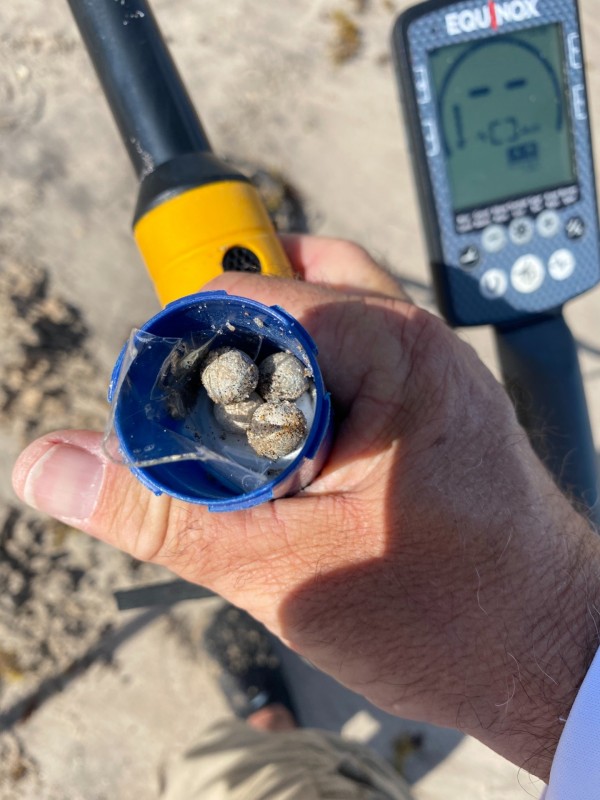
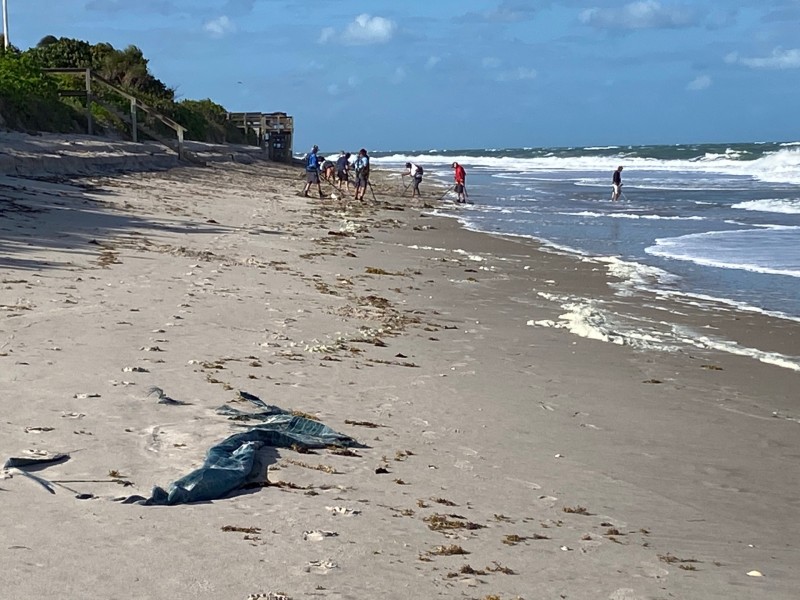
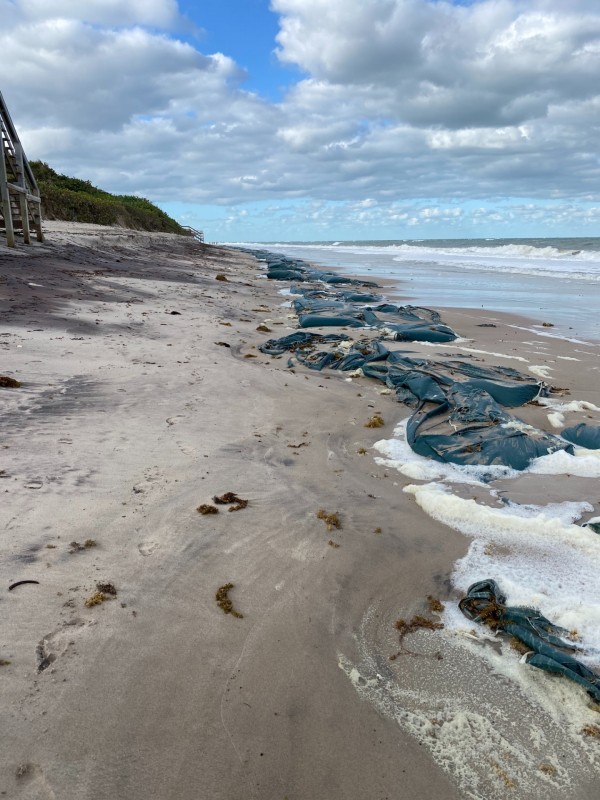
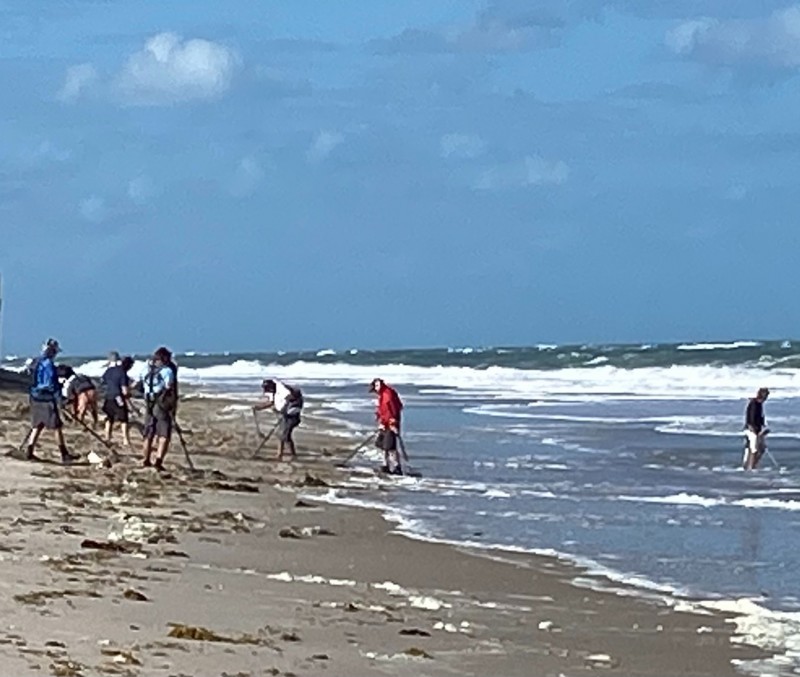

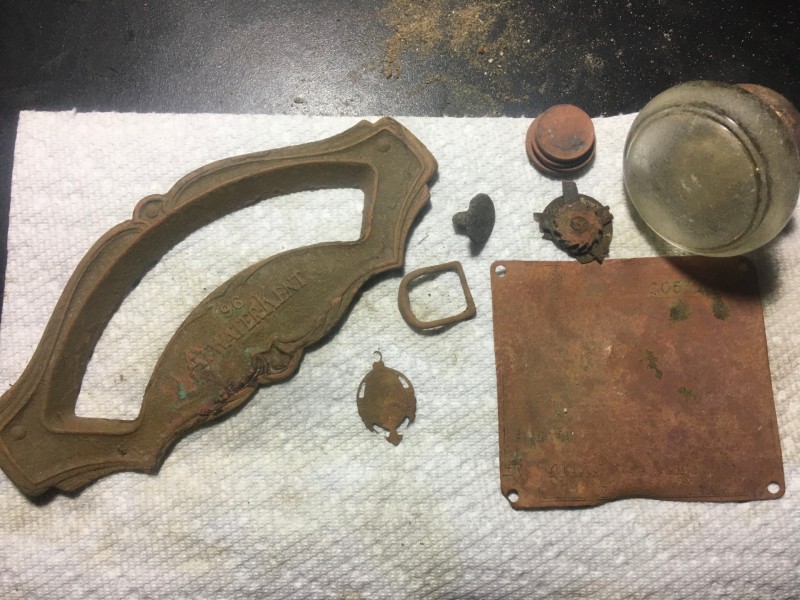
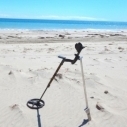
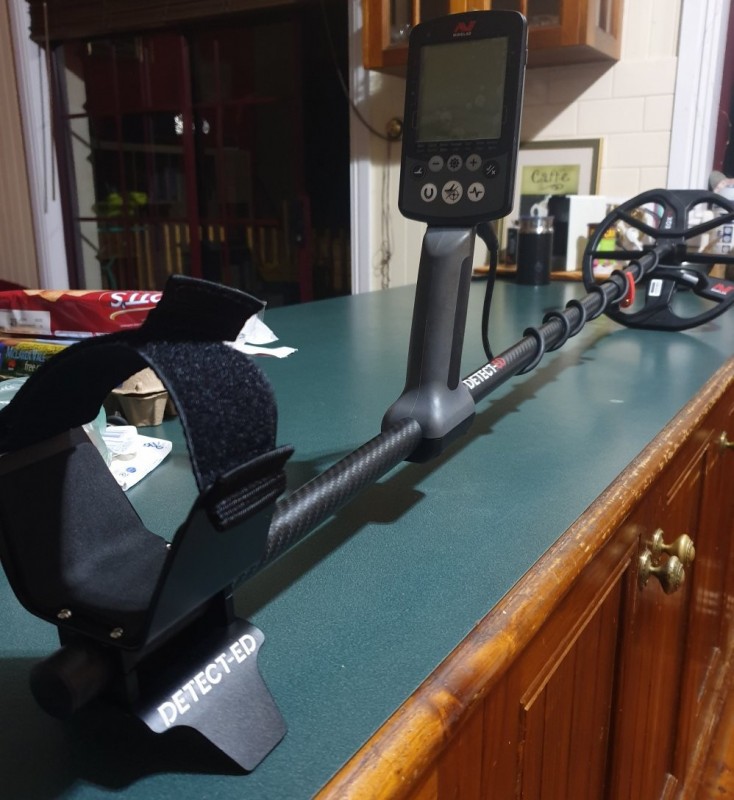
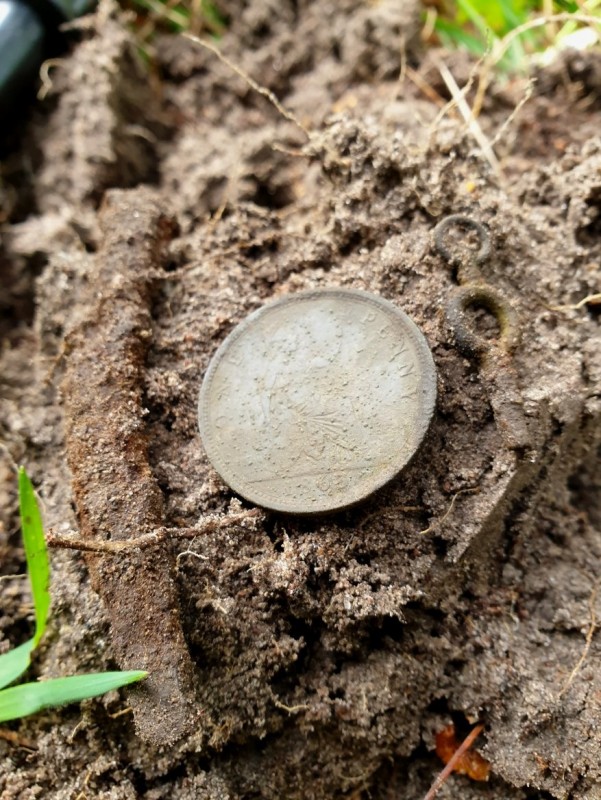
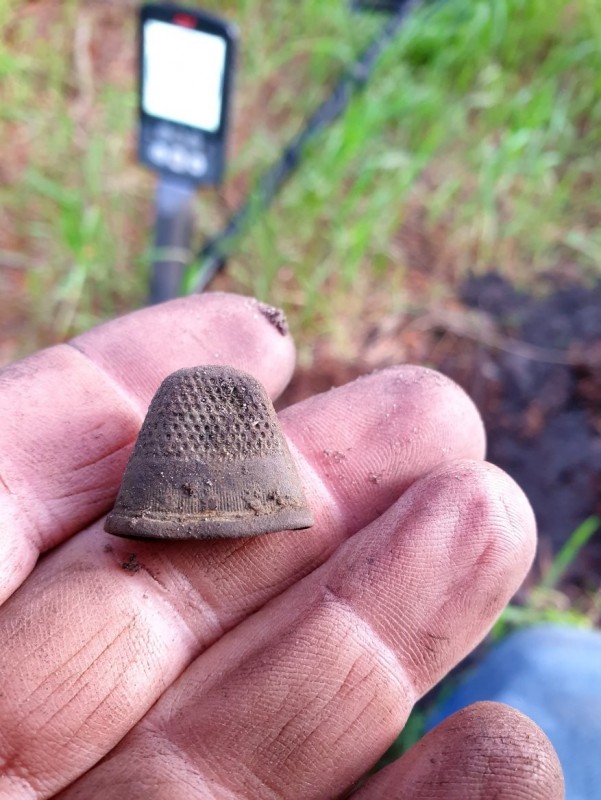
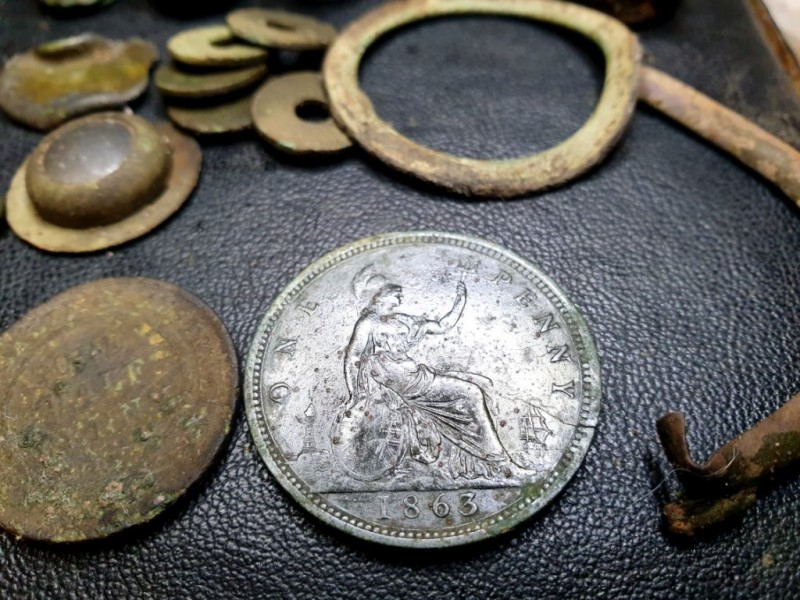
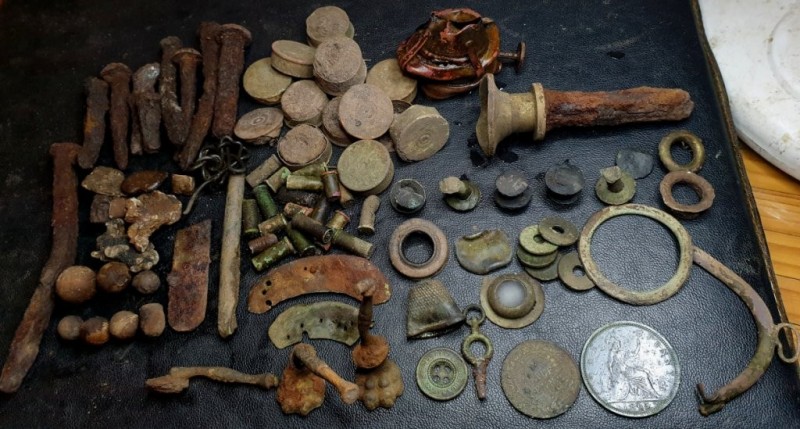
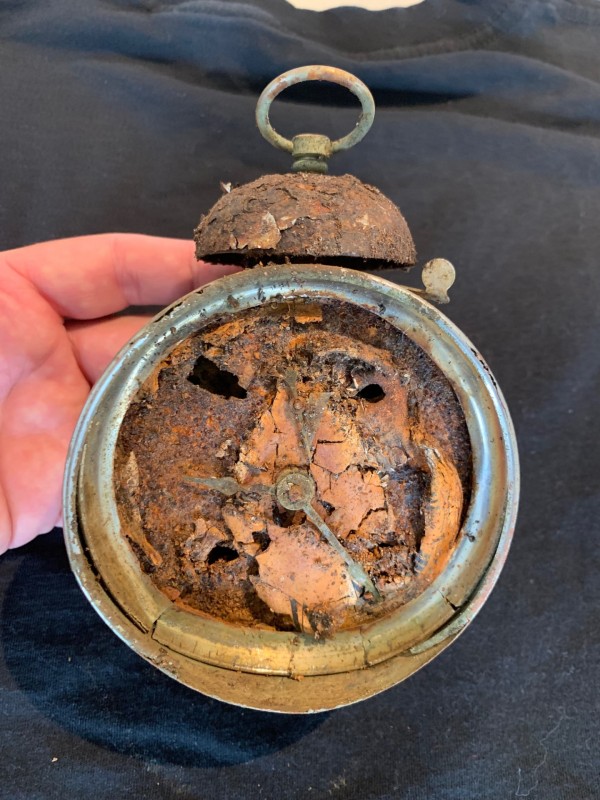
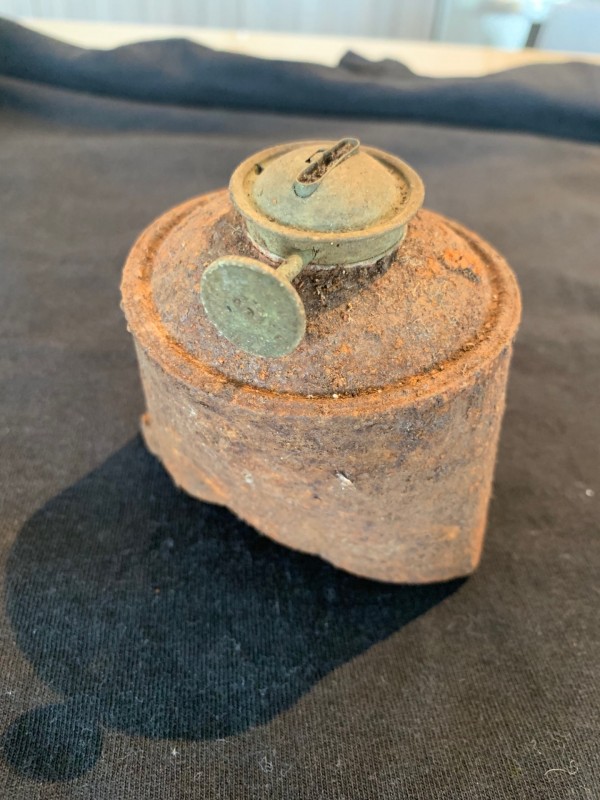
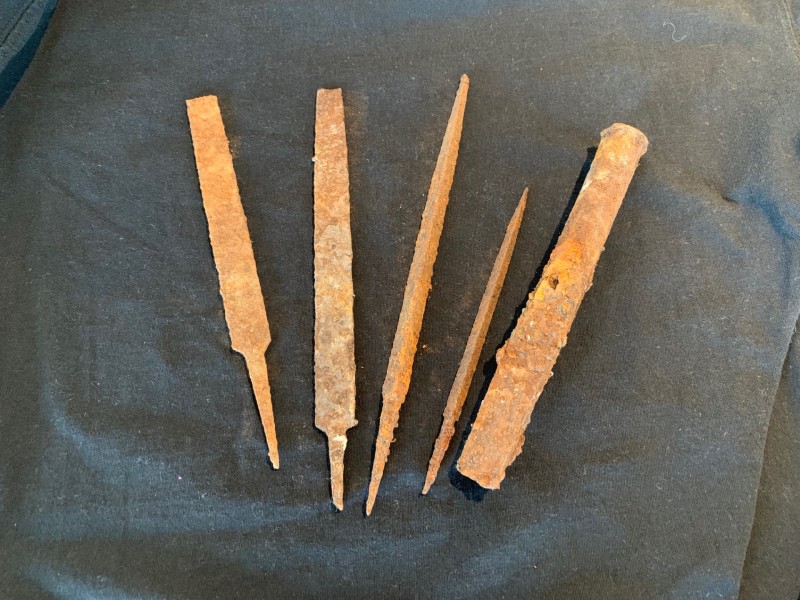
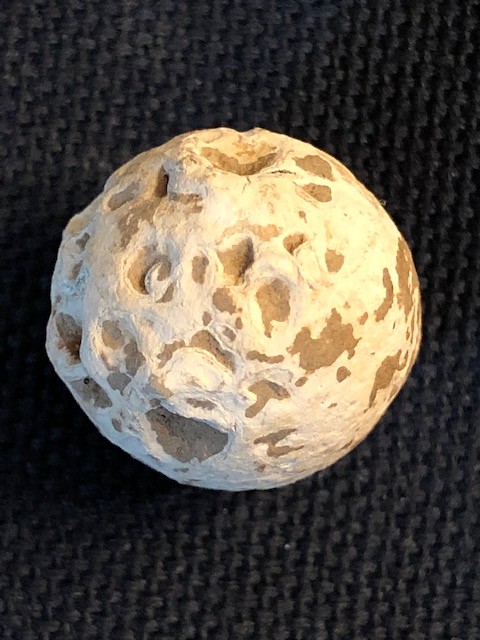
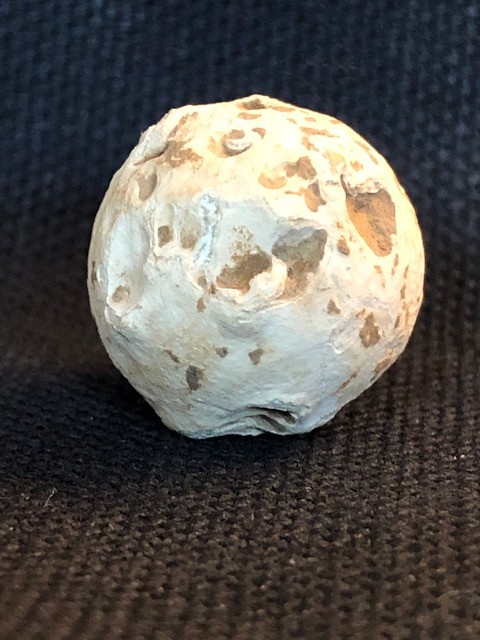
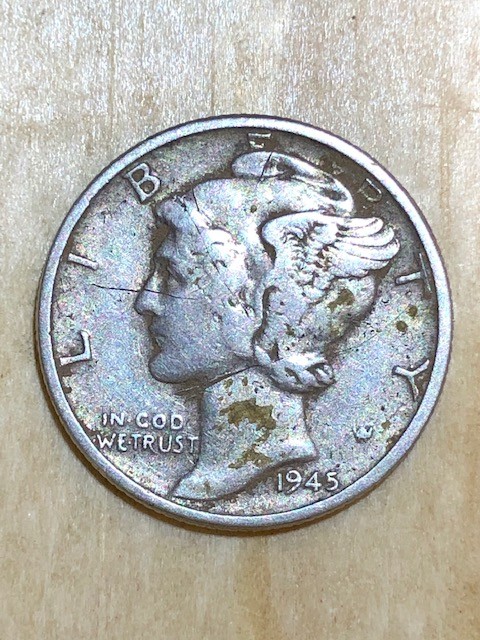
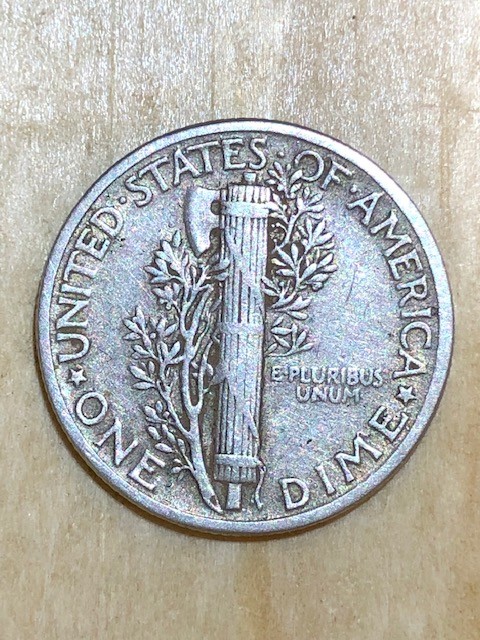
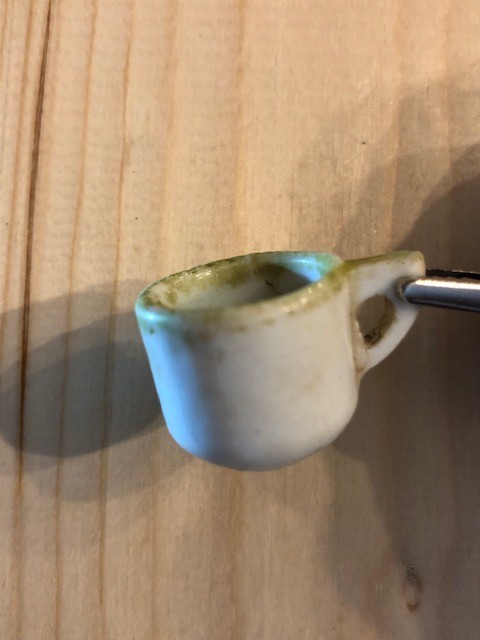
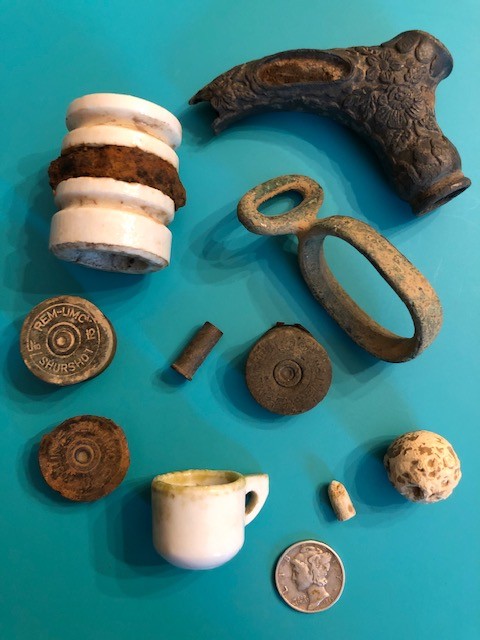
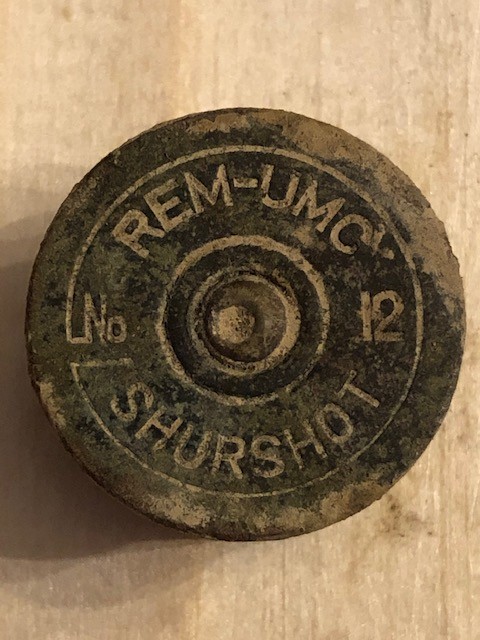
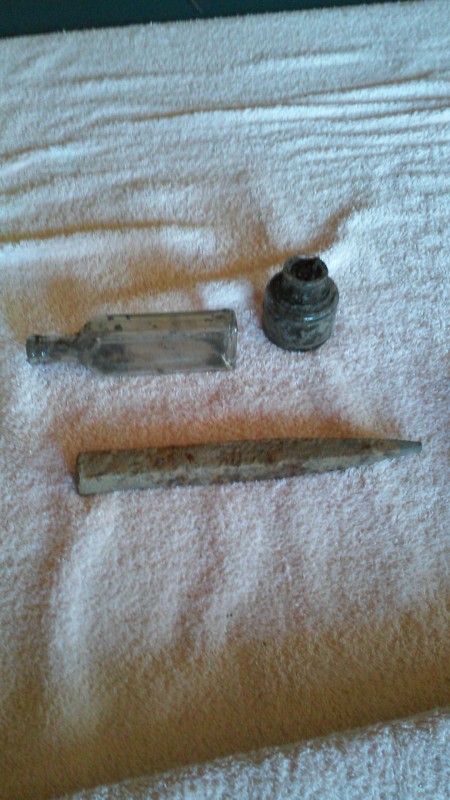

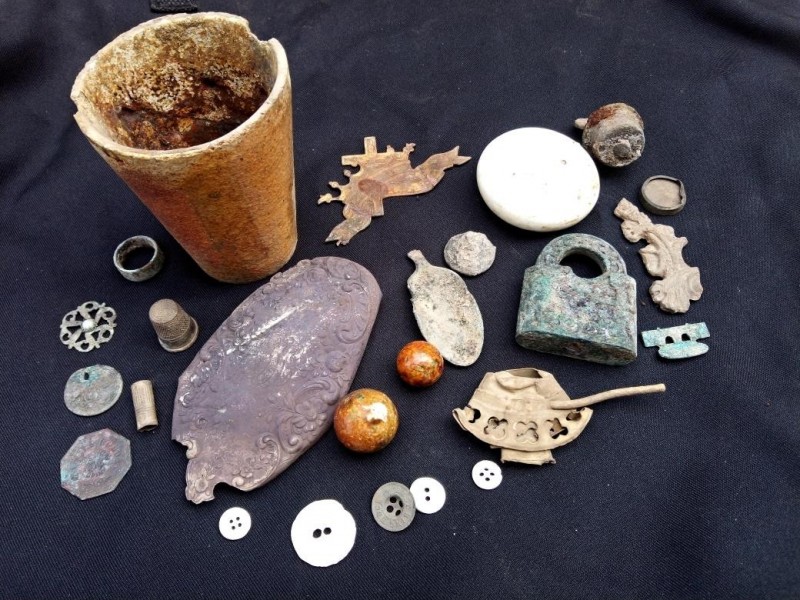
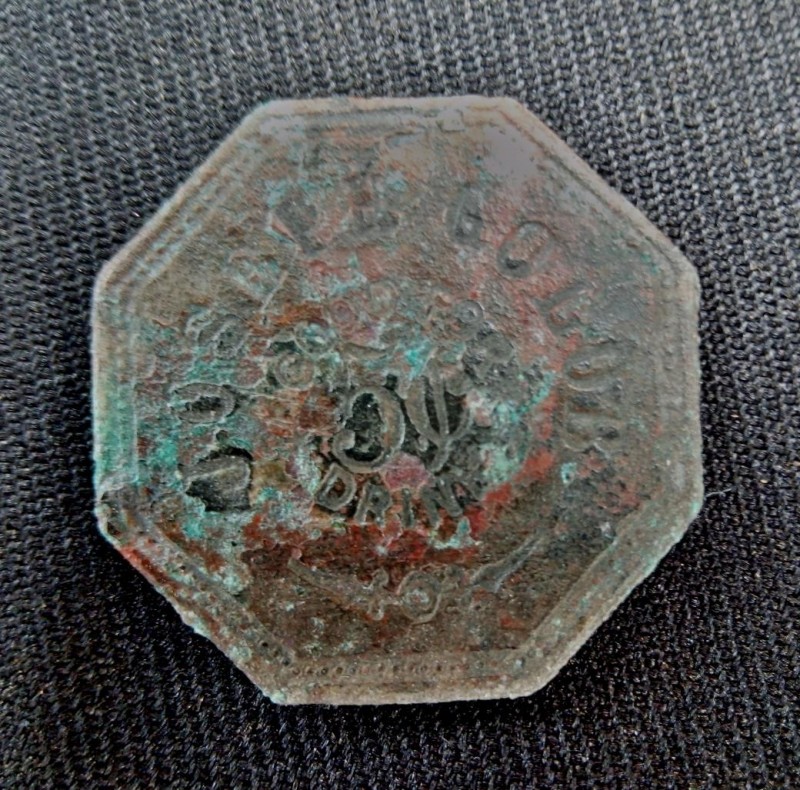
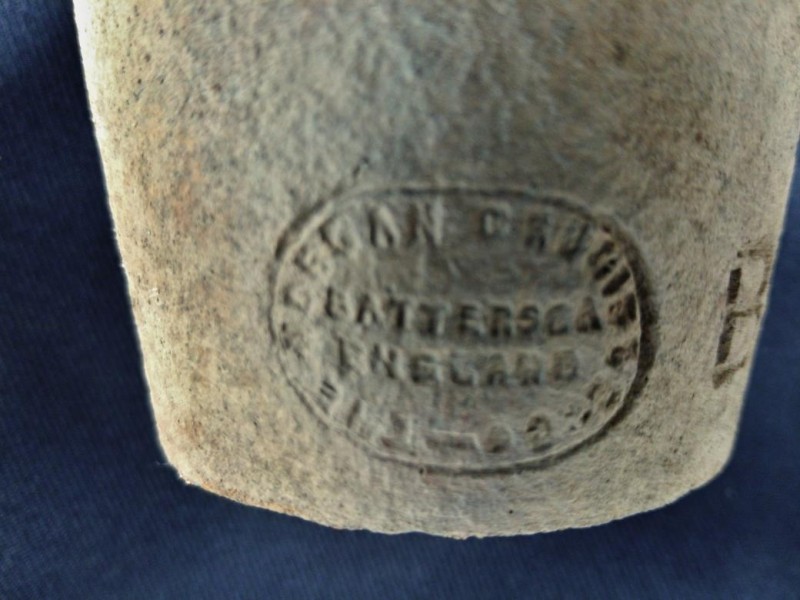
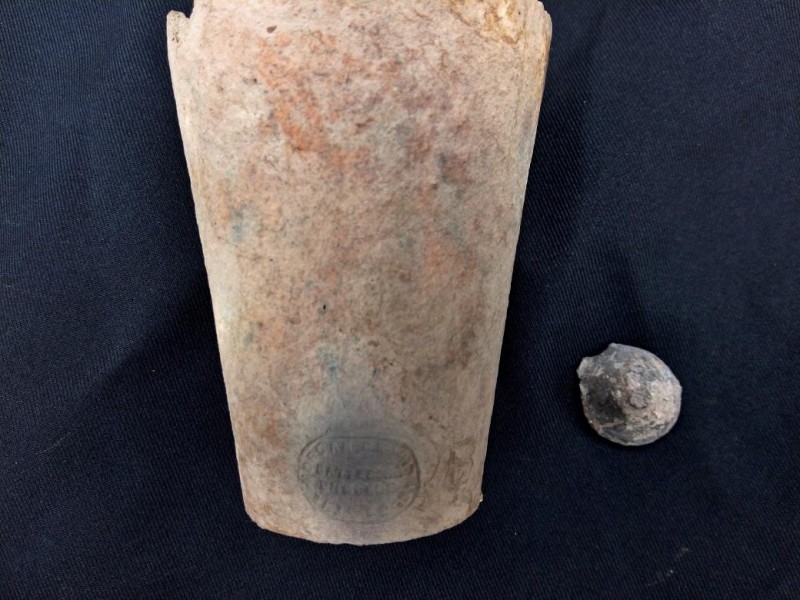
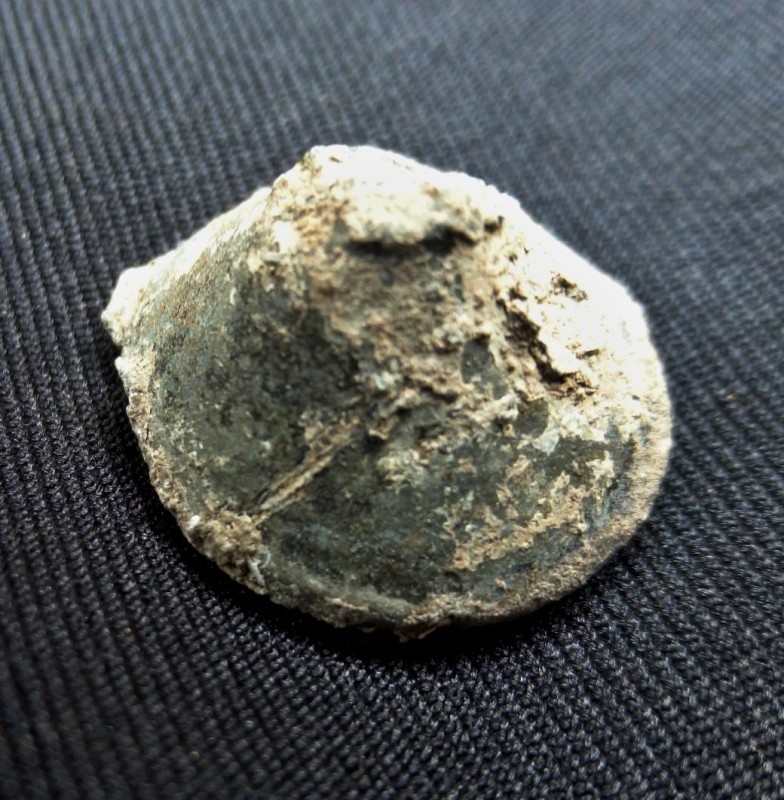
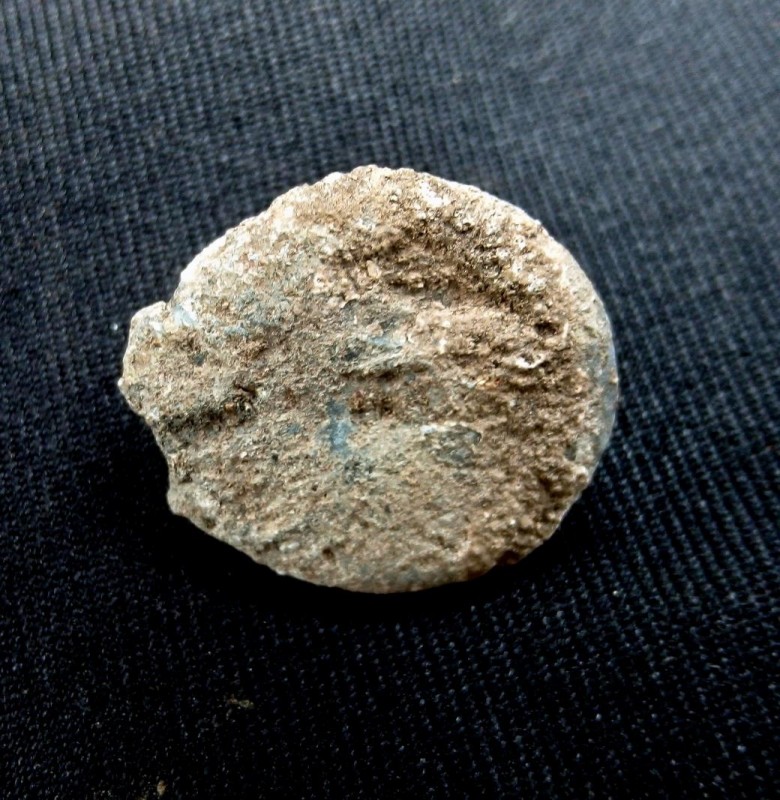
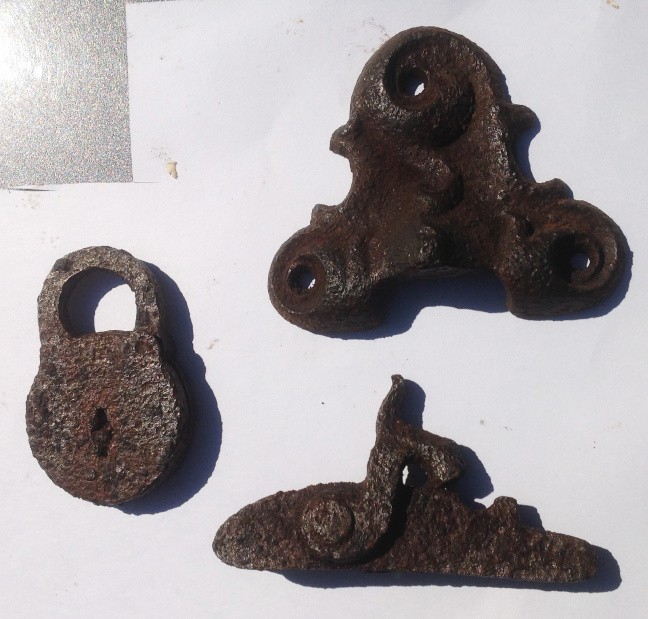
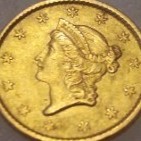
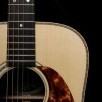
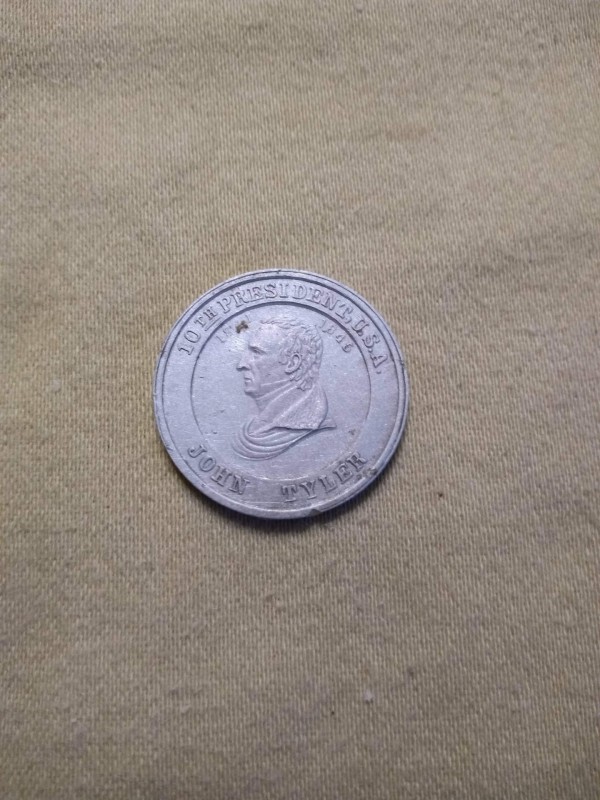
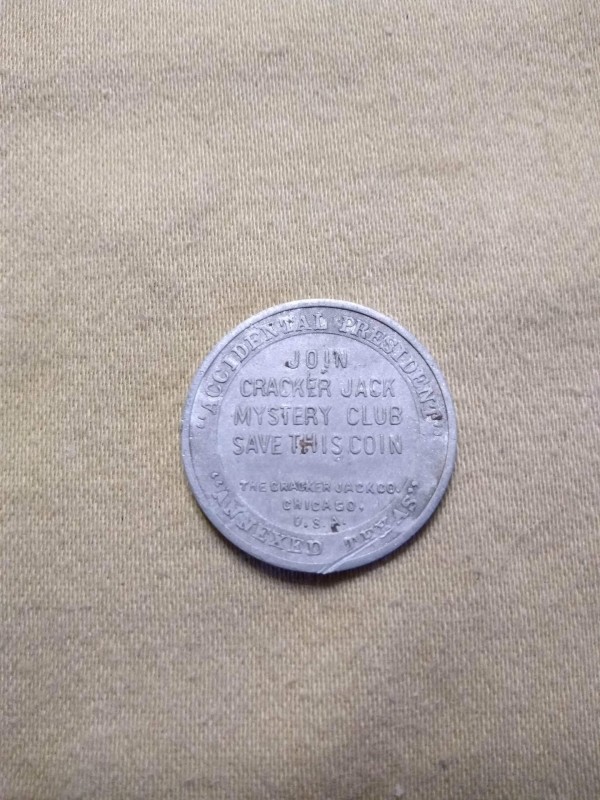

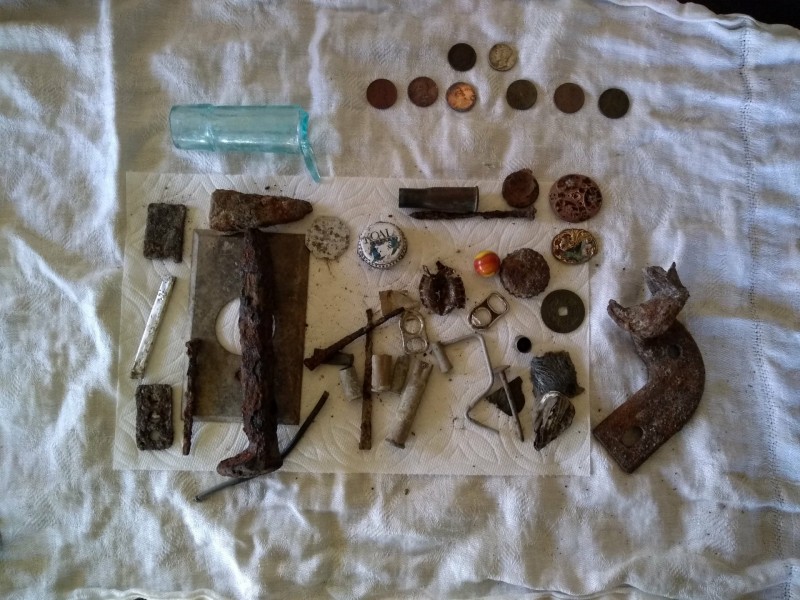
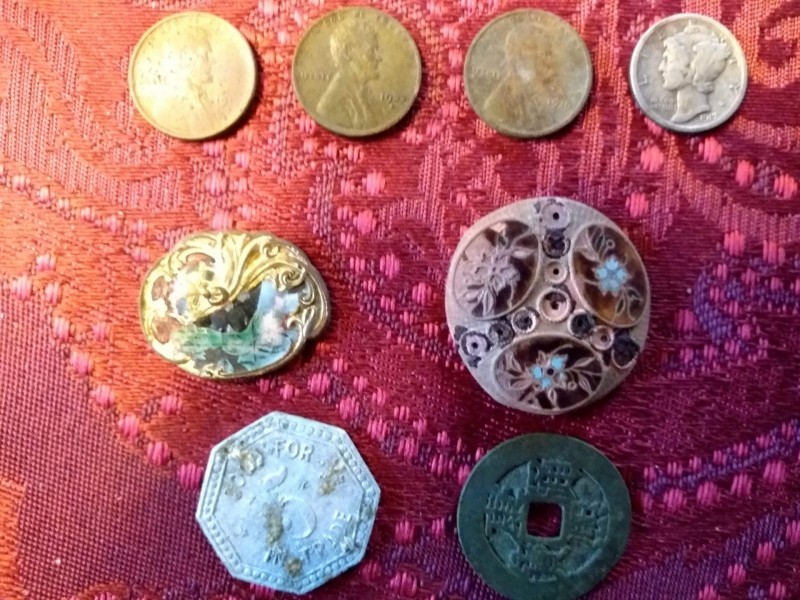
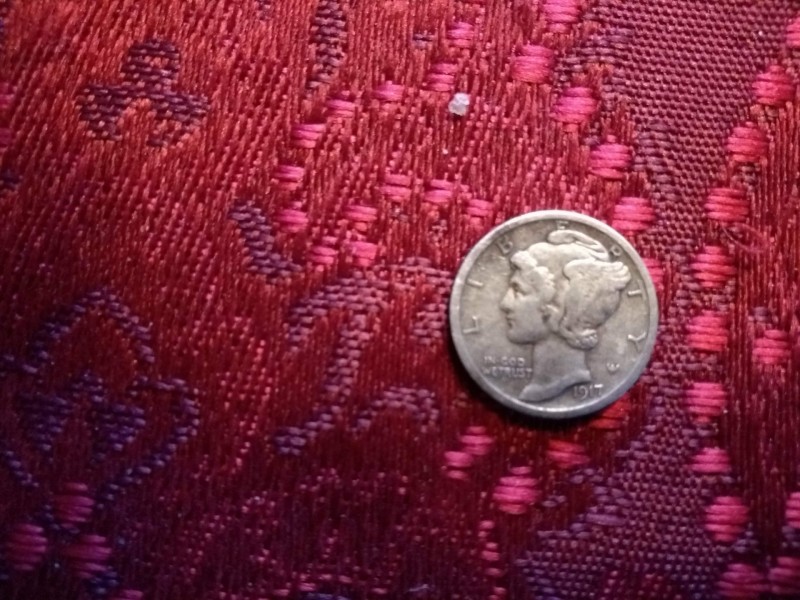
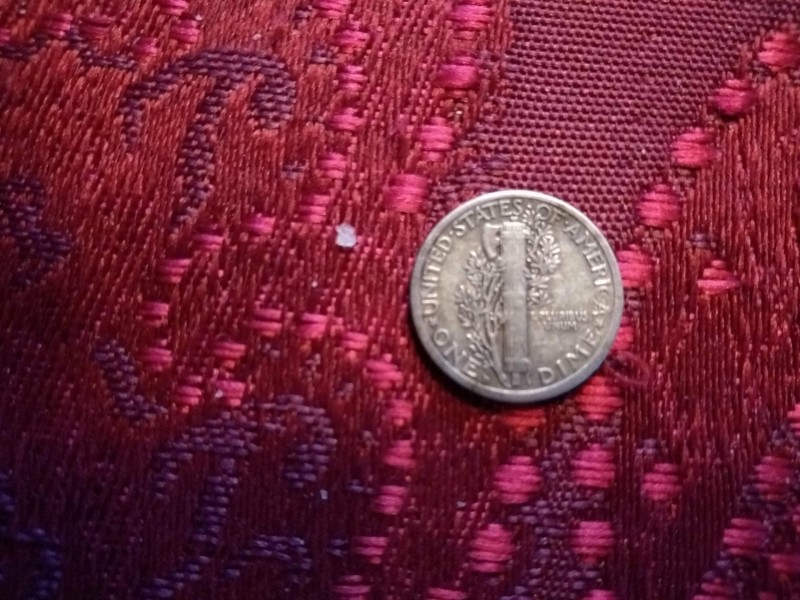
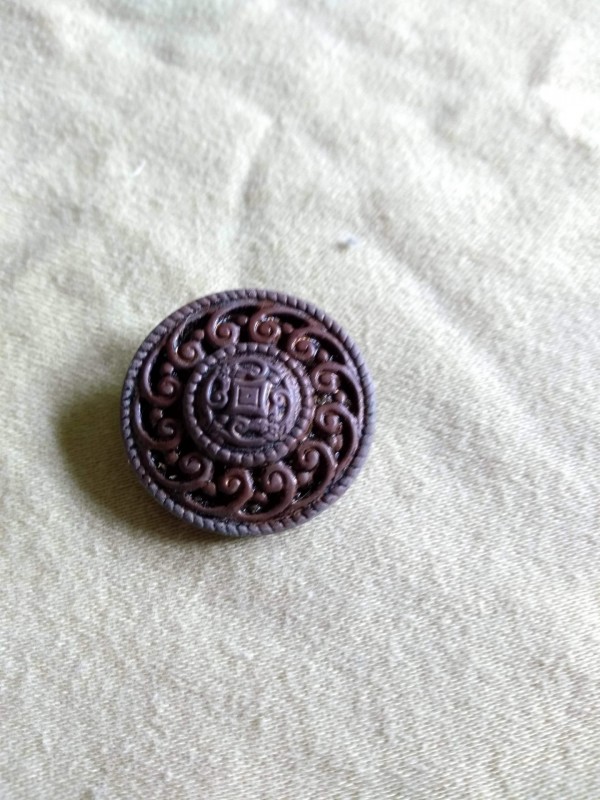
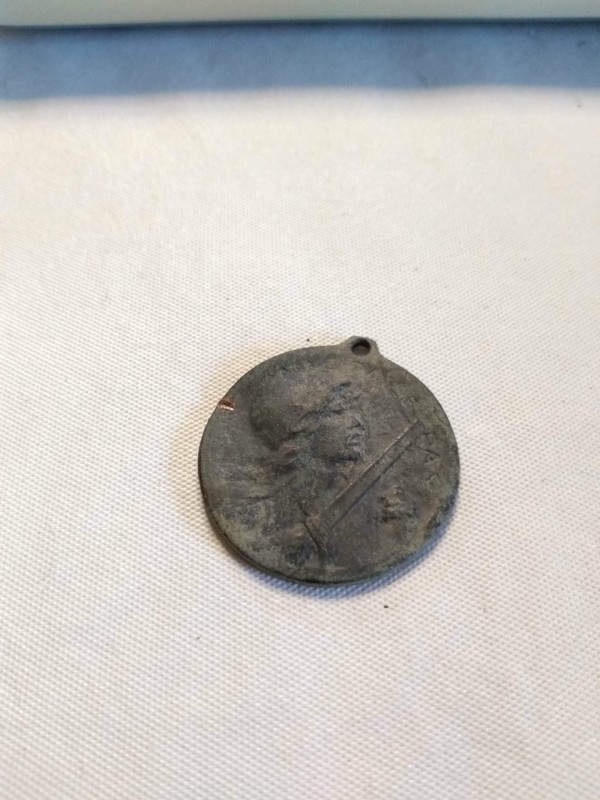
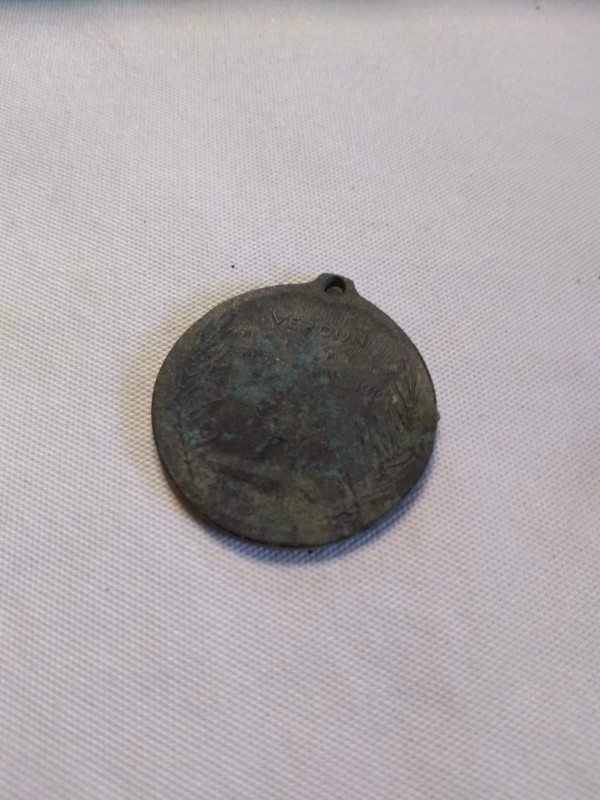
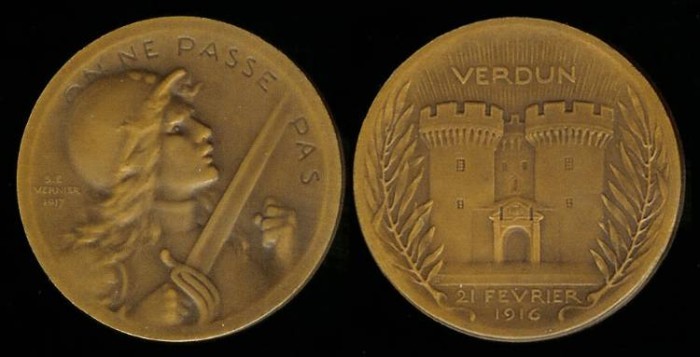
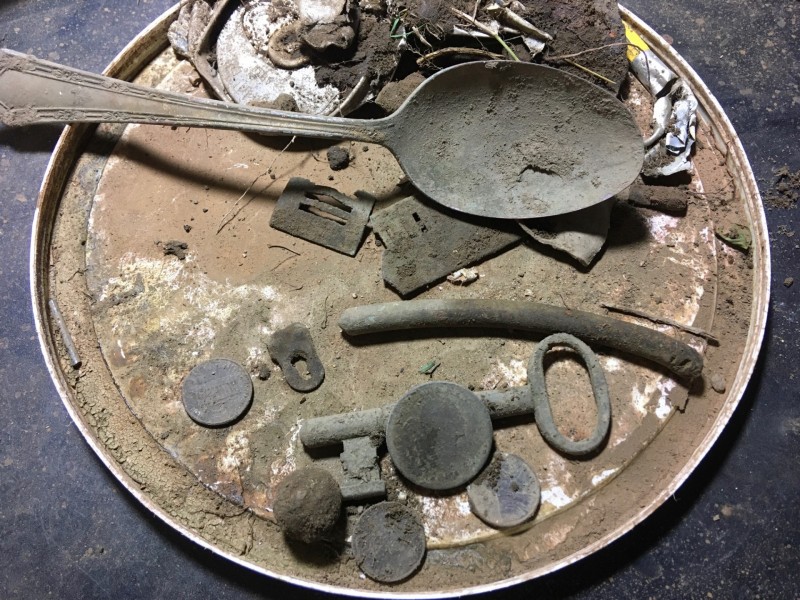
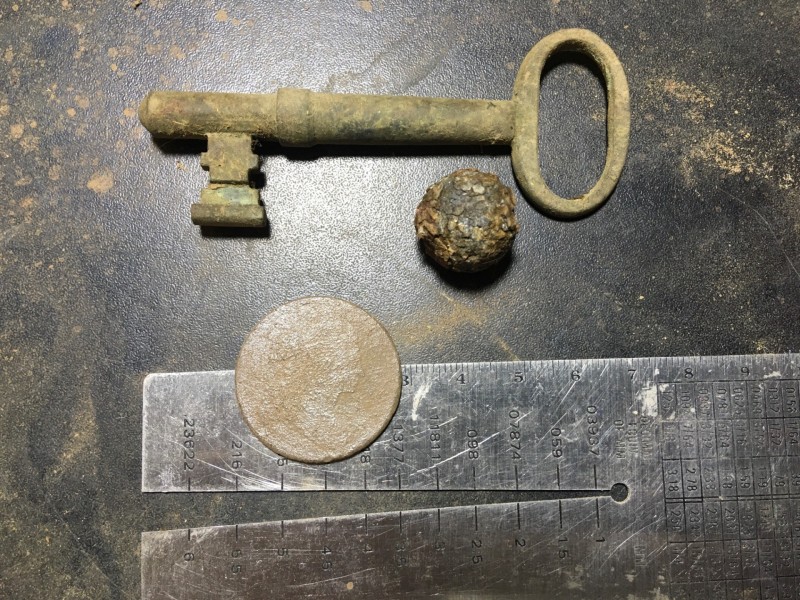
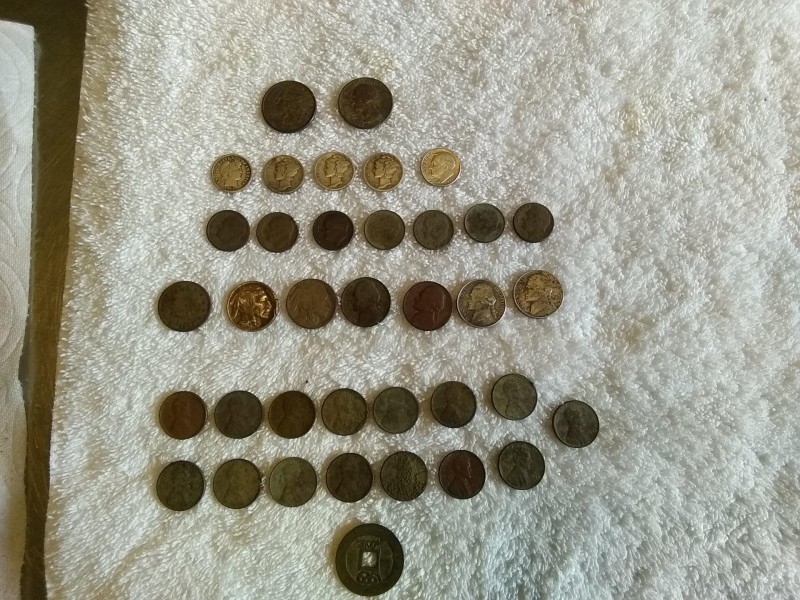
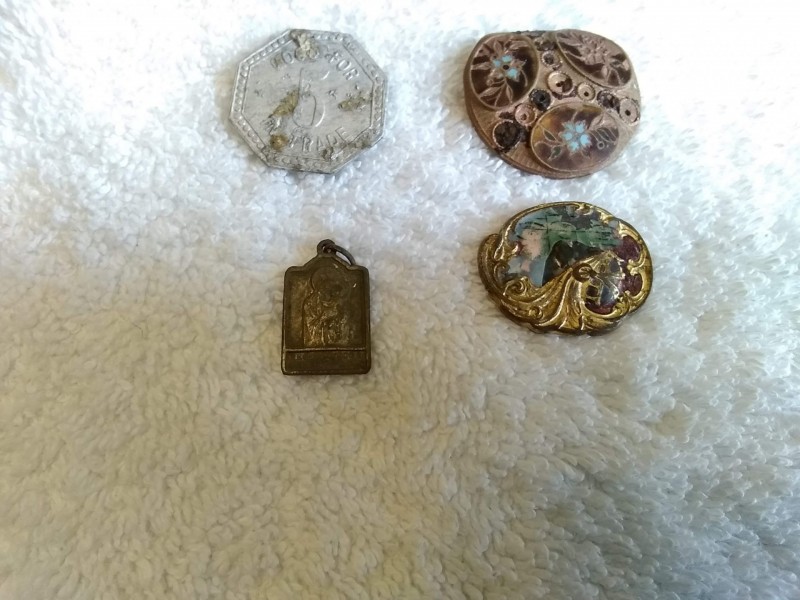
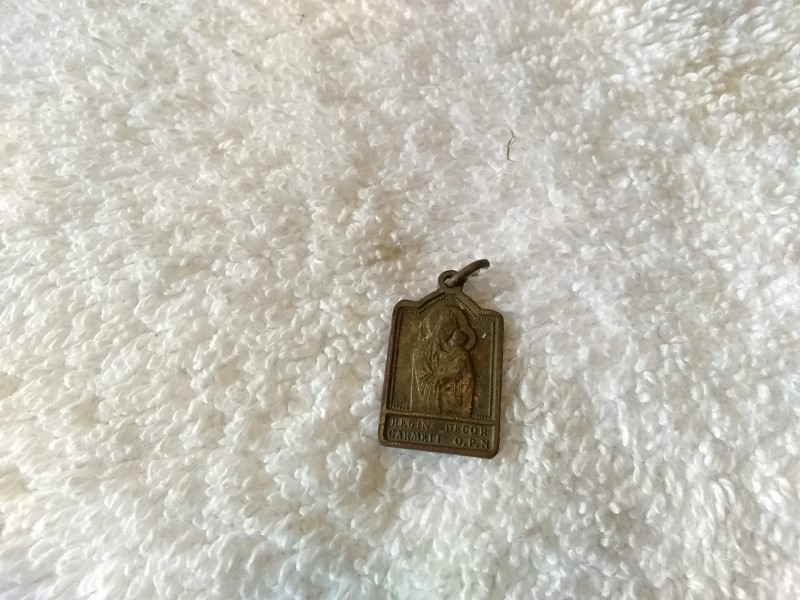
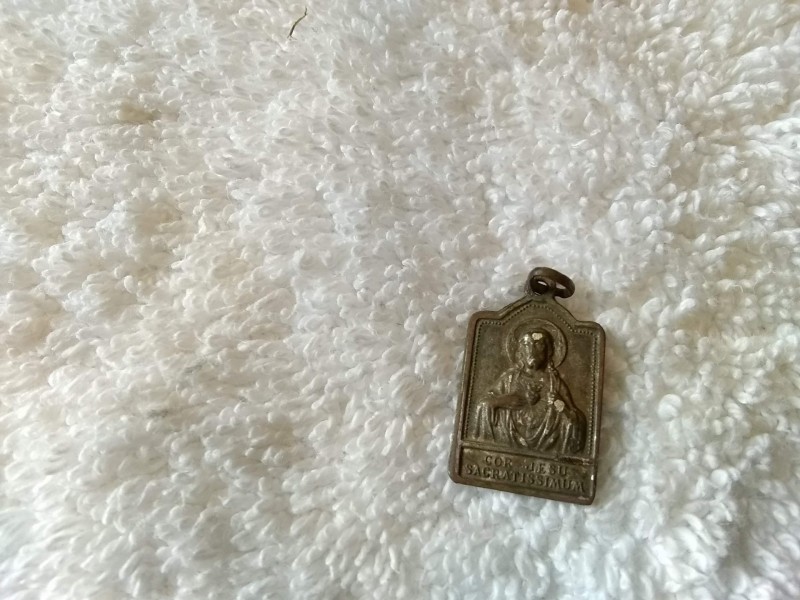
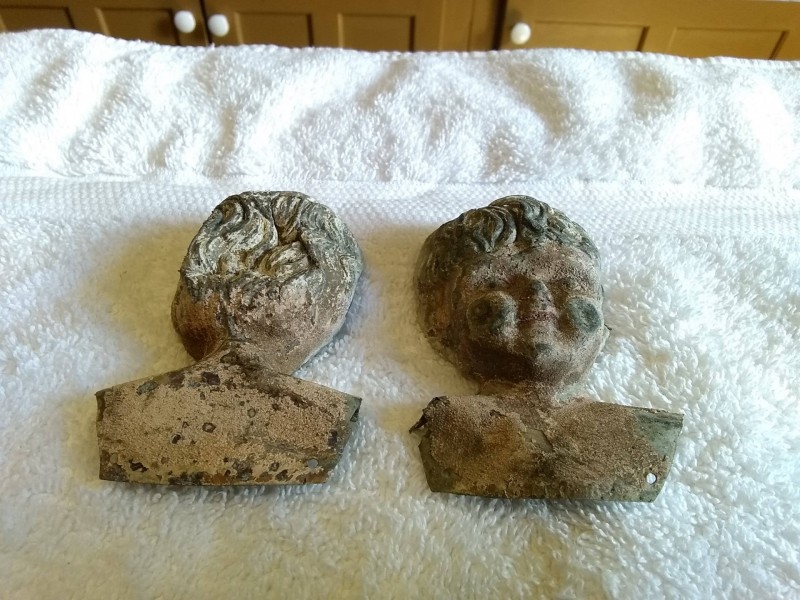
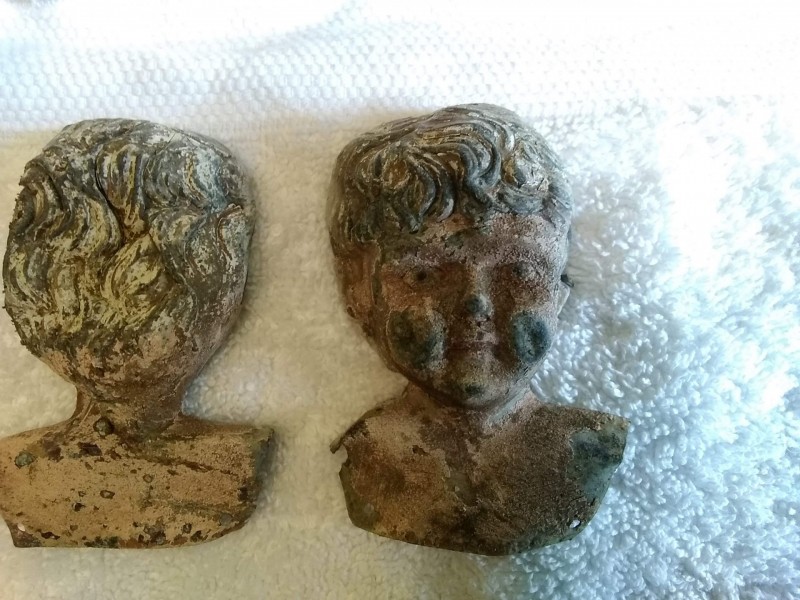
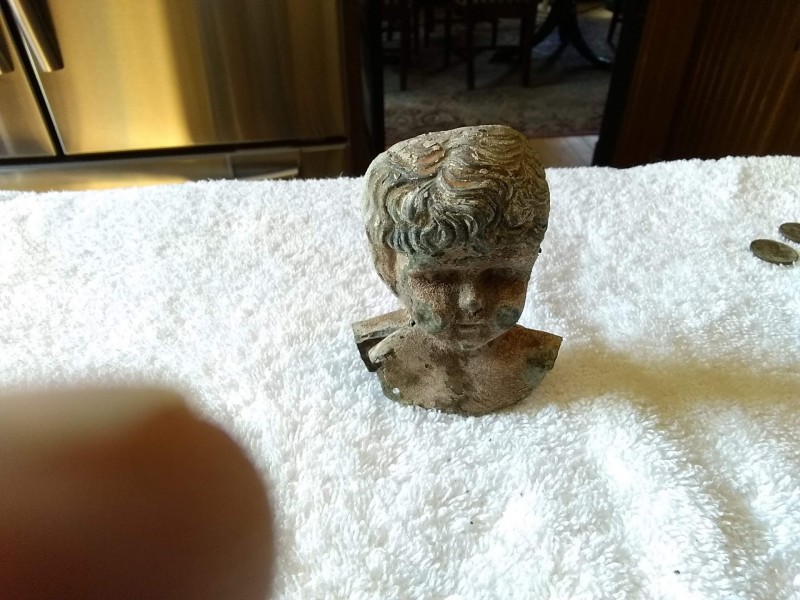
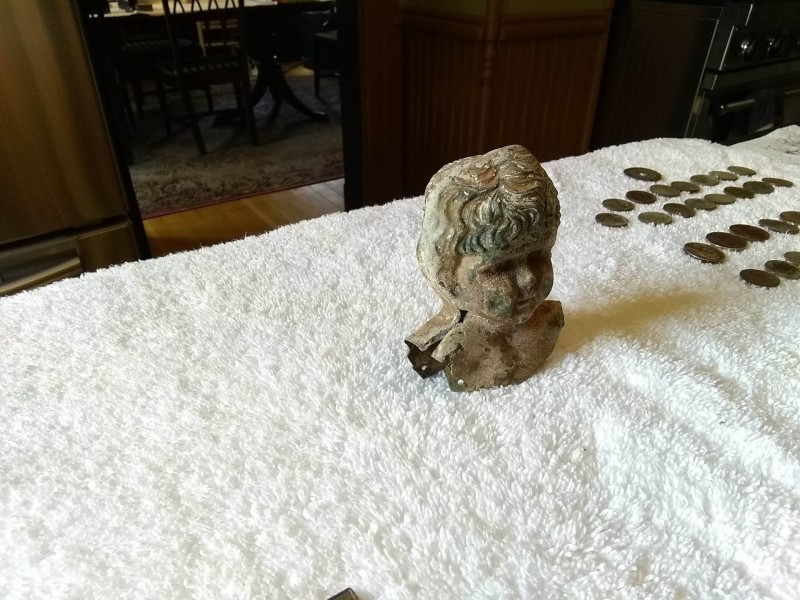
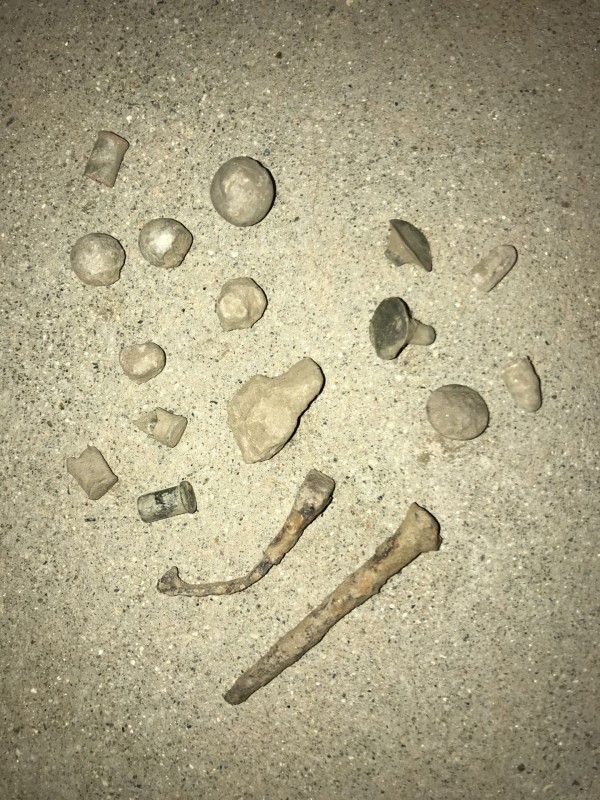
.thumb.jpg.ac5e8ee36e43bcab745dbc623fcf1874.jpg)

